








ONLINE BIDDING OPENS
9 March 2020 | 9am
LIVE AUCTION
19 March 2020 | 7pm
AUCTION & VIEWING LOCATION
Aspire Art Auctions, Illovo Edge, Building 3, Ground Floor, 5 Harries Road, Illovo, Johannesburg, 2196
PREVIEW
11 to 19 March | 9:30am to 4:30pm
COCKTAIL PARTY
19 March 2020 | 5 to 7pm
ABSENTEE/TELEPHONE BIDS
+27 71 675 2991 | bids@aspireart.net
GENERAL SALE ENQUIRIES
+27 11 243 5243 | enquiries@aspireart.net
BID how you choose
In the Room | Telephonically | Absentee | Online | App
www.aspireart.net
Download the Aspire Art Auctions app through the App Store or Google Play.
Select the Gallery Auctions page on www.aspireart.net or simply reg ister via the app.
To register as a first time user: Enter the required personal details (name, email address and password). Click REGISTER.
For returning users: Enter your email address and password and select LOGIN.
When you are ready to place a bid click on REGISTER TO BID and complete the required fields.
Once approved to bid, you will receive an email alerting you of your status as a bidder in the auction.
You can add items to your WATCHED LOTS by clicking the or FAVOURITE ARTISTS by clicking FOLLOW.
You can manually place bids through our website or via our app, or you can enter a commission bid and the system will automatically bid on your behalf up to your maximum amount, but only if someone bids against you.
If you are outbid instantly this implies there is a higher maximum bid from another bidder. You will be notified that you have been outbid via email or push notification immediately after placing your bid.
If you are outbid later you will receive an email or push notification letting you know that you have been outbid and inviting you to bid again.
If two bidders leave the same maximum bid and that increment wins the lot, the bidder who placed their bid first will win the lot.
We can assist with logistics by contacting shipping agents who will provide a quote on your behalf.
All shipping costs are at the buyers’ expense.
Our preferred payment method is by EFT/Wire transfer. Visa and Mastercard payments are also accepted.
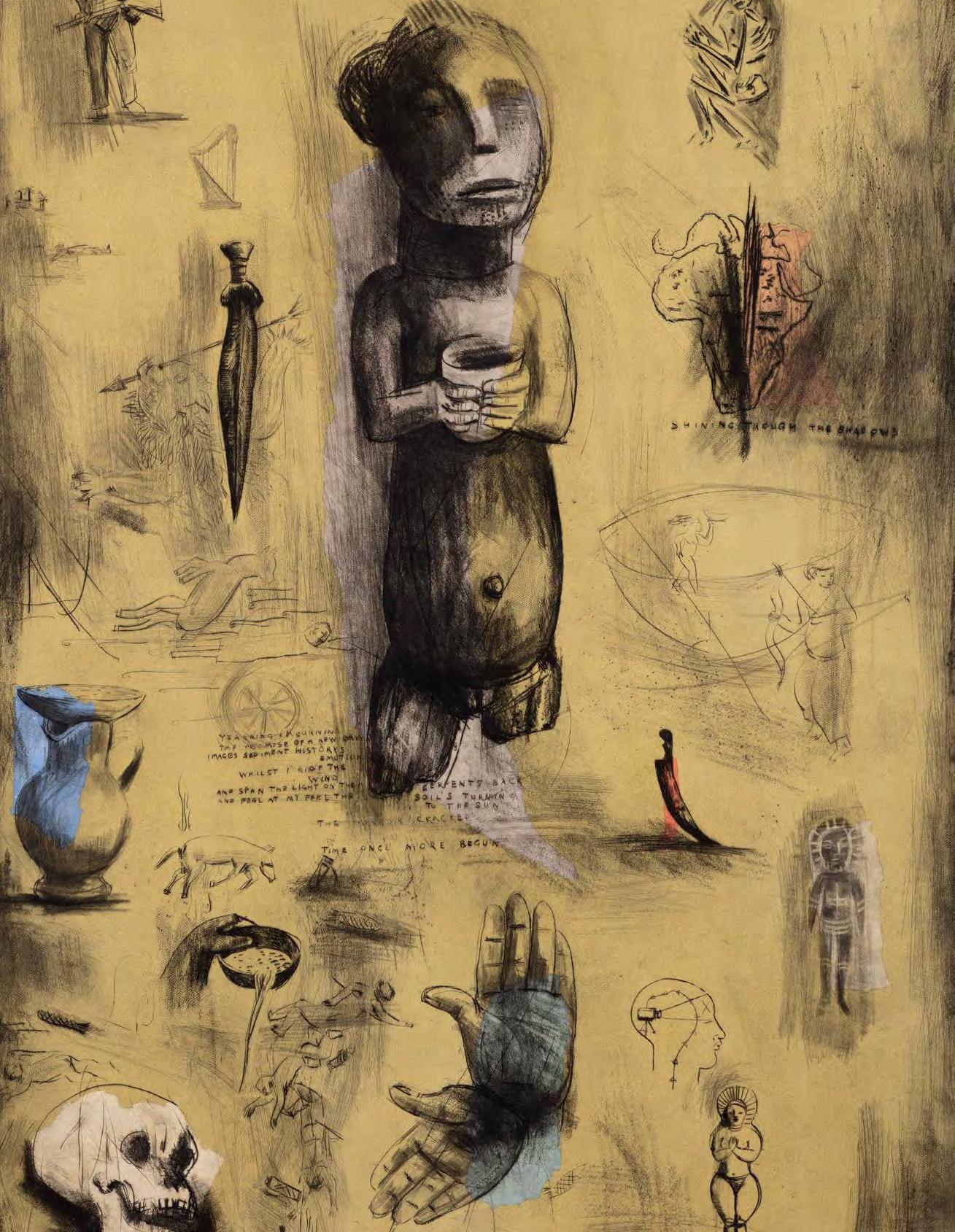
• In order to participate in this Auction you must be registered in compliance with the provisions of the Consumer Protection Act 68 of 2008 and also the Financial Intelligence Centre Act 38 of 2001.
• By registering and bidding you confirm and acknowledge that you are and will at all times be bound by our full Conditions of Business, copies of which are available at the registration table, included in our catalogues and also available online at: www.aspireart.net
• COMMISSION
– Commission charged on this auction is 15%
– VAT is charged on the commission
• All bids are exclusive of VAT and Buyers Premium (Commission).
• The Auctioneer at all times acts as Agent for and on behalf of the Seller of the artwork.
• Artworks are sold subject to a reserve price unless announced otherwise and all sales are final if the reserve price has been achieved.
• Only the auctioneer may bid on behalf of the owner but only to an increment below the reserve.
• The Auctioneer has the right to regulate the bidding and to correct any mistakes made by him/her in the bidding process.
• In the event that an auction is for any reason other than that of a voluntary disposal of goods, the auctioneer shall announce the reason for auction.
• You may not bid on behalf of another person or party unless you have disclosed this fact and you have been authorised to do so in writing and in compliance with the CPA and FICA.
• All Lots once knocked down will be at the risk of the successful bidder.
• No goods may be removed until fully paid for.
• Payment must be made immediately after completion of the auction, as stated in our Conditions of Business.
• All sales once confirmed are final and voetstoots. This means you buy the works as you see them with no warranty or representations.
• Please remember to acquaint yourself fully with our Conditions of Business
https://aspireart.net/wp–content/uploads/2017/02/Aspire–Terms. pdf
• If you have any questions, please ask any member of our team to assist you before you participate in or bid on any lot as the successful bidder will be bound by any bid accepted by the auctioneer.
P.1 P.2 P.4 P.6 P.12 P.102 P.103
AUCTION DETAILS
BIDDING ON THE ASPIRE APP/INTERNET BIDDING
RULES OF AUCTION
INTRODUCTION BY MANDY CONIDARIS
LOTS 1–90
ARTIST INDEX TELEPHONE/ABSENTEE BIDDING FORM
COVER | Lot 4, Robert Hodgins, Crustacea
INTRO | Lot 1, Deborah Bell, Robert Hodgins & William Kentridge, Little Morals Frontis
P.0 | | Lot 55, William Kentridge, The Head and the Load are the Troubles of the Neck
P.3 | Lot 8, Deborah Bell, Shining Through the Shadows
P.10 | Lot 26, Gabisile Nkosi, Endlini yokulala yakithi
BACK COVER | Lot 67, Thamsanqa Rutherford (Thami) Jali, View from the Caversham Press
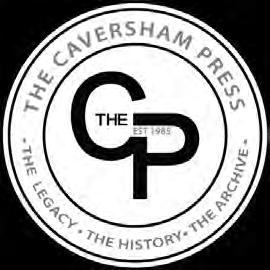
The Caversham Press was established in a small old church in the KwaZulu-Natal Midlands by Malcolm and Ros Christian in 1985. They discovered the church on a journey to their hometown of Durban and straight away decided to settle there, convinced it could house a wonderful printmaking studio. And here The Caversham Press — or Caversham as it is more commonly referred to — was born.
Malcolm’s way of working at Caversham echoes this first act of spontaneity. He has great trust in serendipity, and this conviction has never let him down. Running for over three decades, Caversham has played an integral role in the evolution of our world-class South African printmaking tradition.
To begin, it’s important to clarify what an original print is. The artist creates what is known as a matrix, that is, they work their unique image onto a flat surface which enables multiple impressions of that image to be transferred onto paper via a process of hand inking. This forms an edition of identical artworks on paper. Although the artist creates this matrix, the artwork is not the matrix itself but rather the edition of impressions — or prints.
The edition of prints is limited to a number agreed upon by the artist and printmaker. The resulting printed image must be approved by both — the artist signs the print to indicate their approval and the printmaker ‘chops’ the print with their unique chop-mark to show that they are satisfied for collectors to know that this print was produced in their studio.
Many art lovers are confused by the idea of an editioned print versus a one-off artwork, such as a painting. They believe that a one-off work is the only kind of original work, not realising that a print is equally original since the image is a hand-printed impression from a matrix created by an artist. In fact, the artist’s act of creating the matrix is known as ‘origination’. When the printmaker inks up the matrix to print an edition, every single mark made by the artist, however subtle, will be transferred onto the paper. So, an original print is an impression of specific marks made by the artist which will reveal their unique style of working.
Because original prints exist within a limited edition on paper, they are more accessible in terms of availability and price. Buying such a print is a great way to own an original work by your favourite artist — and, even better, may spark off a lifelong appreciation for the creative effects achieved only by printmaking processes.
Many collectors think that a printmaker just provides technical assistance: an artist wants to make a print so goes to a professional printmaker — known as a master printmaker — to handle the technical side. But it’s about so much more than that, as is reflected in the Caversham ethos.

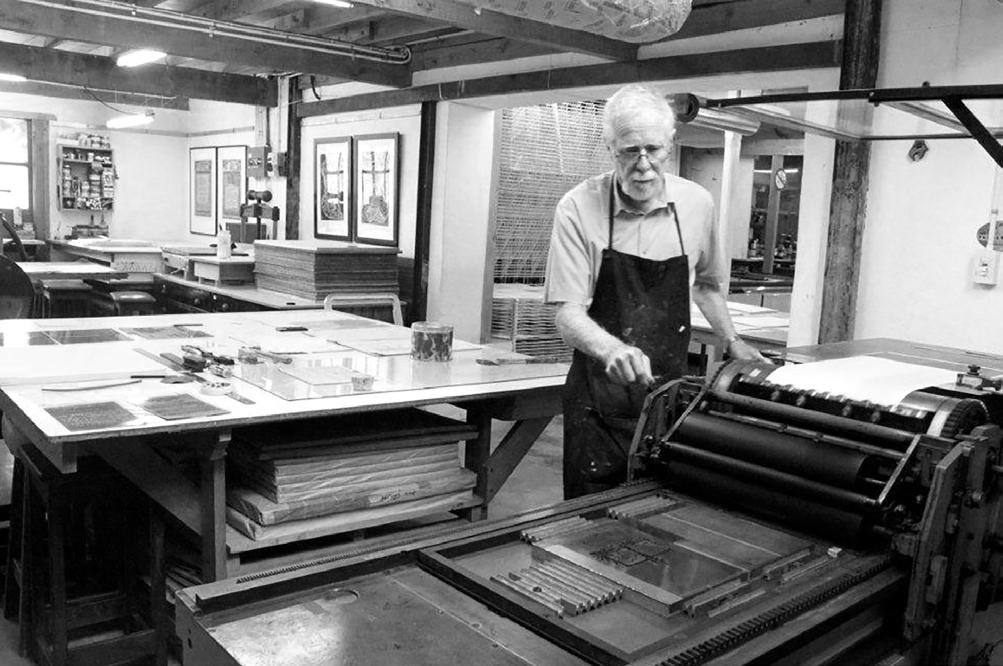
Continued from p.6
Printmaking is collaborative by nature. Yes, the artist creates the image; and yes, the printmaker makes the work happen technically. But somewhere along the line, they start to bounce ideas off each other. The printmaker offers insights into the possibilities inherent in different techniques; the artist may be inspired to shift aspects of their image or even change techniques. They may each share their knowledge of what’s happening in the contemporary artworld. This creative joint process enables the growth of a relationship and connection that may continue over years. Caversham is about three decades of building such relationships, many of which have turned into life-long friendships.
In printmaking, once the human factor becomes involved, events happen, both humanly and/or technically tragi-comic. Moods are accommodated (or not), people bring their life experiences and current emotions to the studio, and at Caversham, Malcolm would instigate conversations that may be anecdotal, philosophical and/or spiritual. Caversham is about stories and each print embraces its own story — this holds true for every print in this curated auction, as well as for the other hundreds of prints produced at Caversham over the years.
Since Caversham is located in the KwaZulu-Natal Midlands, artists could detach from their dayto-day life and time-based commitments. Daytimes at Caversham were spent working hard in the studio with Malcolm, playing with ideas, making technical explorations, and eventually producing the printed image. Lunch on the stoep and delicious suppers were provided by Ros who, over the years, tirelessly handled studio admin, juggling prints with artists’ needs. Their children, Terry and Sally, grew up sharing their dinner table with some of the country’s top artists and early-career artists, as well as international artists in later years. After supper the artist would retire for quiet contemplation or their YouTube fix. For each artist, Caversham was about creative time-out. Sadly, Caversham has closed its doors to professional printing with artists — but not to its friends.
This curated auction represents just a fraction of the creative work undertaken at Caversham over its three decades of existence. Malcolm has worked one-on-one with individual artists for their own portfolios and exhibitions; undertaken commissioned projects; conceived group projects that have focused on the zeitgeist of that specific time; and organised a series of international residencies where artists from other countries have made prints alongside local artists, resulting in significant exchanges of ideas for all concerned. In addition, along with Gabisile Nkosi, he set up the Caversham outreach programme.
As a master printmaker, Malcolm is best known for his outstanding screenprinting, developing this technique from its traditional association with hard-edge colour to more painterly possibilities. He was skilled in many other techniques, and Caversham could offer artists lithography, relief printing, many etching processes and often combinations of more than one. In recent years, Malcolm began to make small-scale artists books.
Any professional printmaking studio has always been about one printmaker’s vision and commitment. This is so at Caversham, as well as at every professional printmaking studio in our country. Local art collectors are extremely fortunate to be exposed to the print work and collaborative skills of South Africa’s creative and superbly trained master printmakers.
Mandy Conidaris, Auction Curator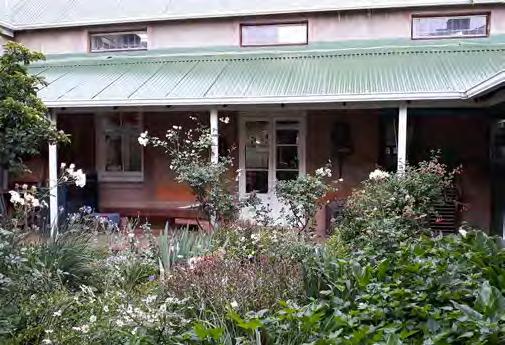

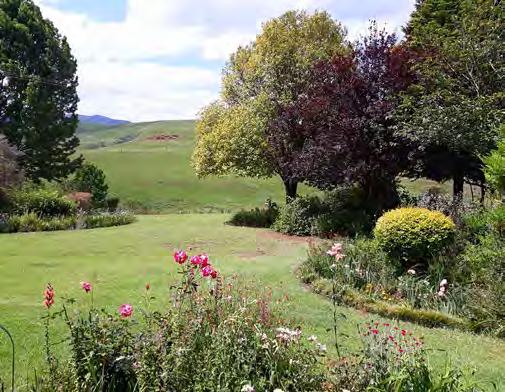
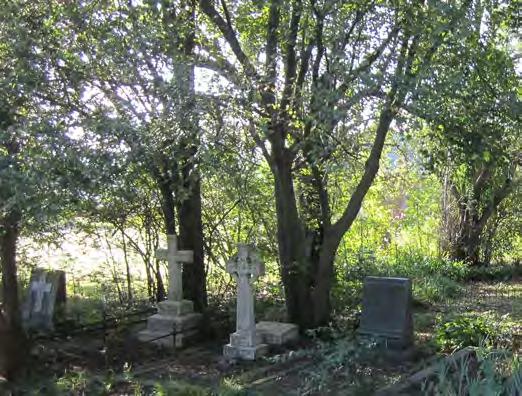

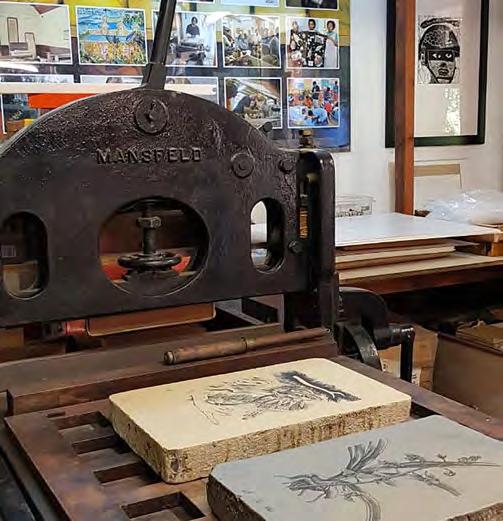
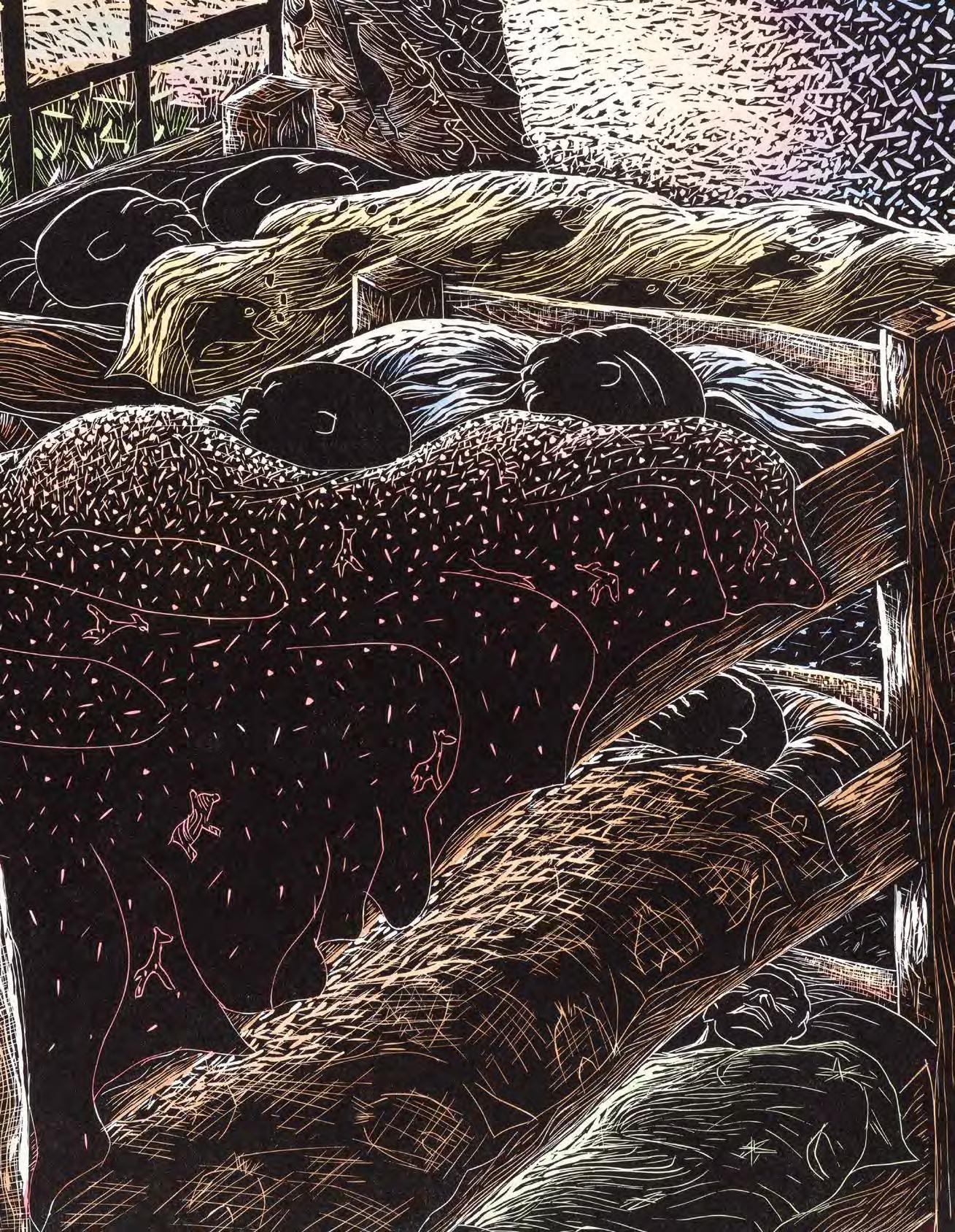

1
b.1957, 1920 and 1955 South Africa
Little Morals Frontis 1990
R40 000 – 60 000
etching with drypoint and handcolouring signed, dated, numbered 28/45 in pencil in the margin and embossed with The Caversham Press chop mark; printed with the title and artist’s names in the plate image size: 25 x 30 cm; sheet size: 33 x 44 cm
Buys, A. (2012). A Lasting Impression: The Robert Hodgins Archive. Johannesburg: Wits Art Museum, another example from the edition illustrated in colour on p.152.
Deborah Bell, Robert Hodgins, and William Kentridge forged long-term relationships with both The Caversham Press and with each other, leading to the creation of three collaborative print portfolios - Hogarth in Johannesburg (1986), Little Morals (1990-91), and Ubu Tells the Truth (1996-97) - as well as numerous individual prints.
The works they produced during their print collaborations reflect the quality of Caversham’s first decade of printmaking as well as articulating the artists’ personal perspectives of living and creating in South Africa in the years between late apartheid and the transition to a new democracy.
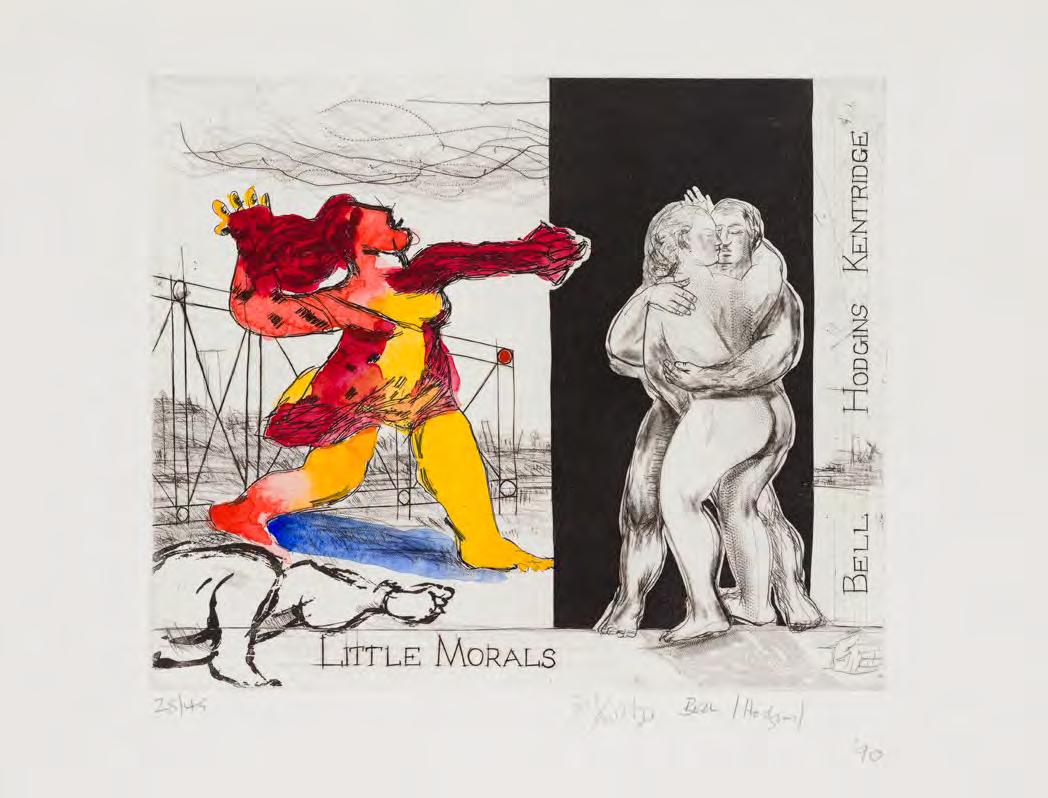
2011 R30 000 – 50 000
etching with drypoint signed, numbered 24/45 in pencil in the margin and embossed with The Caversham Press chop mark image size: 30 x 22 cm; sheet size: 53.5 x 39.5 cm
The sphinx, here seen cradled in the arms of the artist, illustrates Kentridge’s interest in Ancient Egypt –a theme he has explored since 2004. Having taken on many forms and iterations, the sphinx has featured in the work of the artist as sculptures and drawings. In 2010, the artist explored his fascination with the myths, history, associations and iconography of Ancient Egypt when he presented Carnet d’Egypte at the Musée du Louvre in Paris, a project which responded directly to the museum’s Egyptian Room.

South African 1920–2010
Little Morals, suite of eight prints 1990

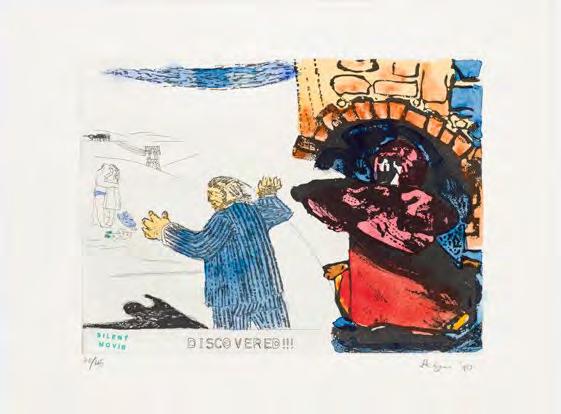
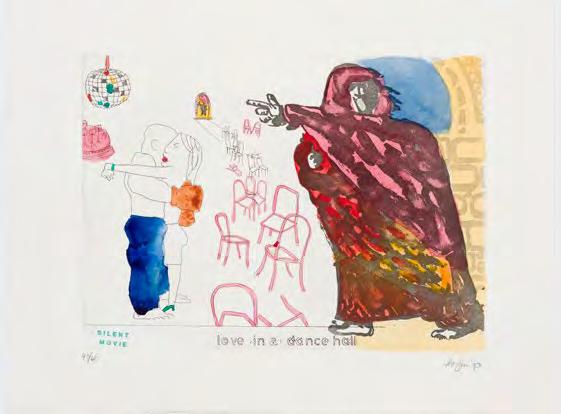
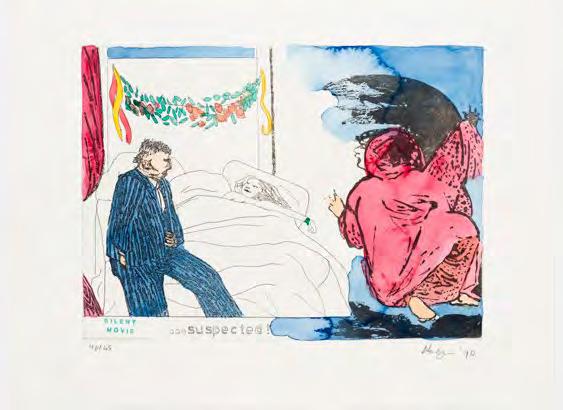
R150 000 – 200 000 hand-coloured etchings each signed, dated, numbered 40/45 in pencil in the margin, printed with the respective title in the plate and embossed with The Caversham Press chop mark image size: 24 x 33 cm each; sheet size: 33 x 44 cm each
Print titles: ...suspected!, hooked & landed, Discovered!!!, love in a dance hall, The End, Tell me the truth, a shot in silence..., this is for you...
Robert Hodgins, Deborah Bell and William Kentridge became acquainted through their involvement in Wits University’s Department of Fine Arts: Bell was tutoring, Kentridge was a student, and Hodgins lectured. At the same time, Malcolm Christian was the printmaking lecturer at Wits. Bell and Hodgins exhibited together as early as 1983 but the first major collaboration between all three resulted in a series of prints entitled Little Morals. What ensued was a flourishing meeting of minds, and the forging of a collaborative process culminating in the production of prints, etchings and animated films.
While satirising the decadent lifestyle and vices of the middle classes in South Africa at the height of apartheid, the artists would nevertheless have been all too aware of how the historic release of Nelson Mandela in February 1990 after 27 years’ incarceration would bring into sharp focus the radical political and social changes which the country was undergoing.
In this suite of 8 hand-coloured etchings, Hodgins elaborates his silent movie, opening with scantily clad lovers in a dance hall and moving through the ensuing drama spelt out in images and subtitles like ‘Discovered’, ‘Tell me the truth’, ‘a shot in silence’ until finally, ‘The End’. In each vignette a dark force or cloaked maternal figure observes the unfolding drama between the lovers and the cuckolded man in his pinstripe suit. With his delicious wit and sense of play, Hodgins has brought his life-long passion for theatre and his wicked sense of humour to bear on the foibles of everyday life in this expressive and amusing suite of etchings.

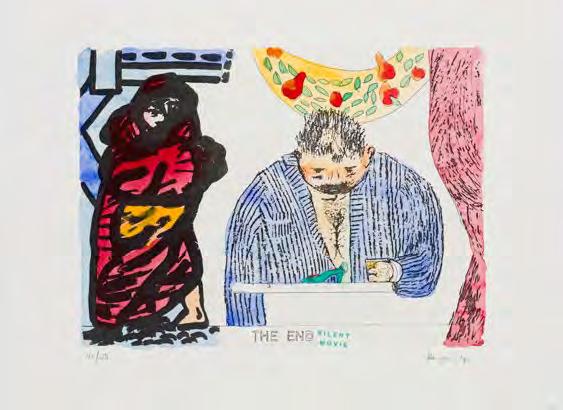

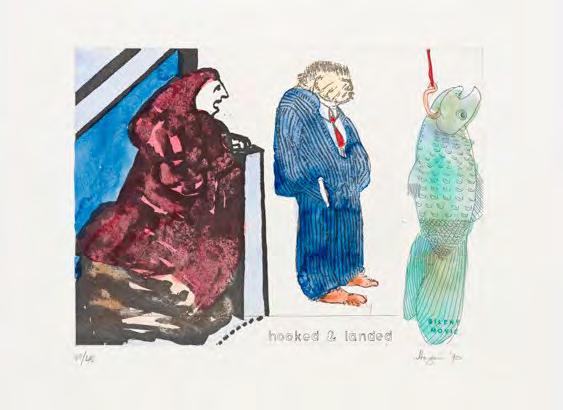
In an interview in 2001 held between Brenda Atkinson, himself, William Kentridge and Deborah Bell, Robert identified the collaborative film Memo (1993/94) as the time he began to work with the suit as subject. He said:
I’ve been thinking about when William [Kentridge] made the movie T and I and I was King Mark for one day. William put me into an Austin Reed suit. Now I haven’t had a suit since about 1965, when my own suit was stolen, and I never bothered to get another one. Debbie [Bell] wet my hair and parted it in the middle; I had a flat reptilian head under this flat reptilian hair … and I was another person. So that’s where all the suit paintings started …
If I look back on my work, there’s no emphasis on the suit before then … after, there’s the idea of the man in the suit who is superior, who at the same time is in a suit of armour … and the sense that, if you’re in a suit of armour and you fall down, you can’t get up again. So the idea arose of the suit of armour as an encumbrance as well as a protection. (2001:60)
Robert Hodgins. (2002). Tafelberg: Cape Town. ISBN 0 624 04065 8
4
Robert HodginsSouth African 1920–2010
Crustacea 1997/8
R35 000 – 45 000
colour screenprints, over two sheets signed, numbered 14/30 in pencil, dated in red ink, printed with the title in the plate and embossed with The Caversham Press chop mark sheet size: 140 x 100 cm combined
LITERATURE Buys, A. (2012). A Lasting Impression: The Robert Hodgins Archive. Johannesburg: Wits Art Museum another example from the edition illustrated in colour on p.36.
In a zoomorphic rendition, Robert Hodgins depicts two businessmen as crustaceans on a rock. Their cigars and cigarettes kept dry above water, as a nod to their consumable concerns. Lobster-like, these two characters illustrate a paradox of value. The lobster dish is notoriously the most expensive dish on a respectable restaurant’s menu, the type of place you would take colleagues, clients or a lover and order this as an impressive show of your opulence. The paradox lies in the fact lobsters are very much the bottom feeders of the sea. Scouring the ocean floor for leftovers, dead bodies and decaying matter. Hodgins continues his tradition of parodying the suit wearing corporate type whose focus is on wealth and consumption, but I doubt he would describe them as wealthy, just two scavengers that have made it to the top…of a rock.

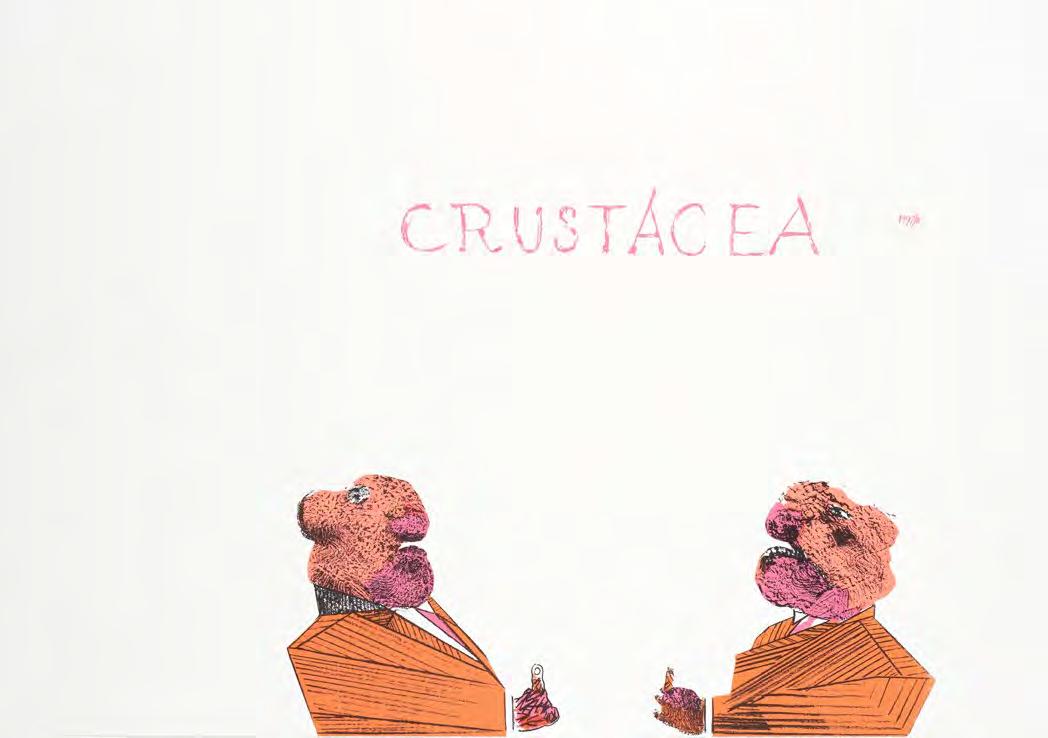
Pastime 1992
R20 000 – 30 000
hand-coloured stone lithograph signed, dated, numbered 6/35, inscribed with the title in pencil in the margin and embossed with The Caversham Press chop mark image size: 28 x 42 cm: sheet size: 50 x 65 cm

1990
R10 000 – 20 000 stone lithograph with colour screenprint signed, dated, numbered 15/20 in pencil in the margin and embossed with The Caversham Press chop mark
image size: 30 x 48 cm; sheet size: 50 x 66 cm
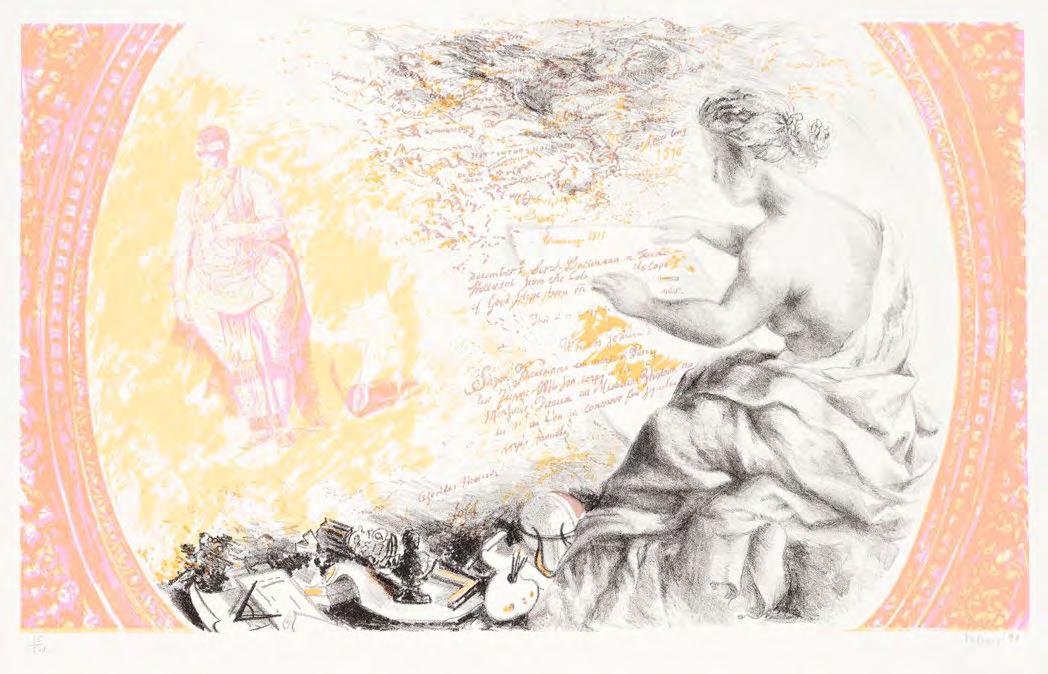
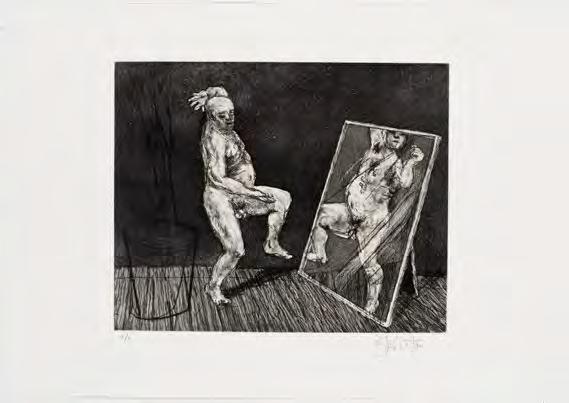
b.1955 South Africa
Untitled (Black Ubu), suite of 8 prints 1997
R200 000 – 300 000 etchings with drypoint each signed, numbered V/X in pencil in the margin and embossed with The Caversham Press chop mark image size: 25 x 30 cm each; sheet size: 35 x 50 cm each


In 1997, Robert Hodgins, Deborah Bell and William Kentridge began working on their third collaborative project, UBU: ±101 which celebrated the centenary anniversary of Alfred Jarry’s seminal play Ubu Roi (1886). Working under the same theme, the artists would each envision their own contemporary South African interpretations of Ubu – the greedy, gluttonous tyrant.
Kentridge’s suite of eight prints are centered on Ubu the everyman, the Ubu in each of us. As such, the artist used his own nude body as the study for this work. This particular set of prints is from a preliminary edition of 10 which have been numbered in Roman numerals. For print portfolio Ubu Tells the Truth, the plate was further editioned as a set of 50, but then each was overprinted with a second plate of drypoint inked in white.

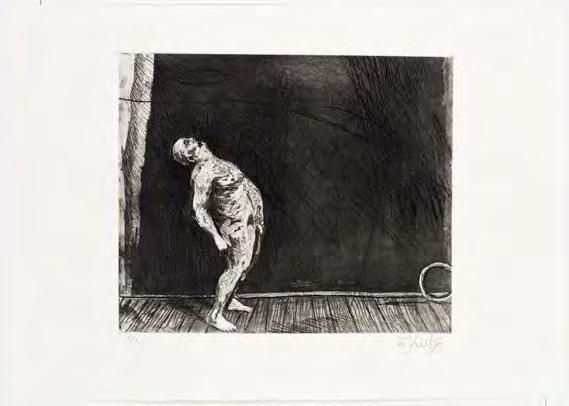
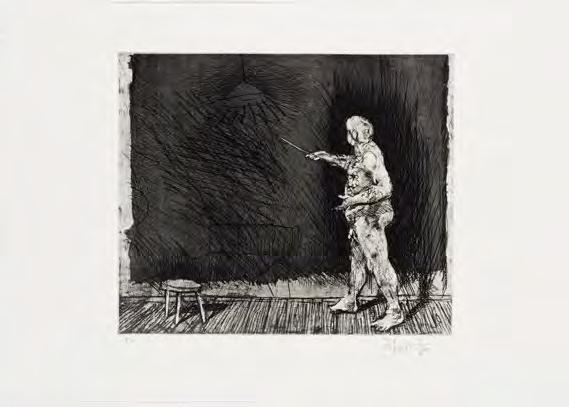


R45 000 – 60 000
drypoint with chine collé on hand-coloured paper signed, dated, numbered 6/35, inscribed with the title in pencil in the margin and embossed with The Caversham Press chop mark image size: 96 x 59 cm; sheet size: 100 x 71 cm
LITERATURE Stein, P. (2004). Deborah Bell. Johannesburg: David Krut Publishers, another example from the edition illustrated in colour on p.29.
Between 1999 and 2000, Malcolm conceived his first Hourglass Project where international and local artists, in this case women, worked together in groups. The focus for this project was ‘Icons for the Millennium – Past, Present and Future, a Women’s Vision’. This is Deborah Bell’s contribution.
Shining through the Shadows is a meditation on life and hope. Based on Bell’s diaries and sketches from the British Museum, the central figure holding a vessel, is surrounded by images of spiritual transformation and potential – the jug references Picasso’s Still life with a Jug (1937) while the eyes on the open hand allude to a meditational breathing position which allows for energy to funnel through them. Through the complex overlaying of images and artefacts, Bell represents what she calls ‘history’s emotion’ – histories and memories recorded yet holding the promise of new beginnings1.
1 Adapted from Pippa Stein ‘The Journey Home’ in Stein, P. et al. (2004). Deborah Bell. Johannesburg: David Krut Publishing, p.28
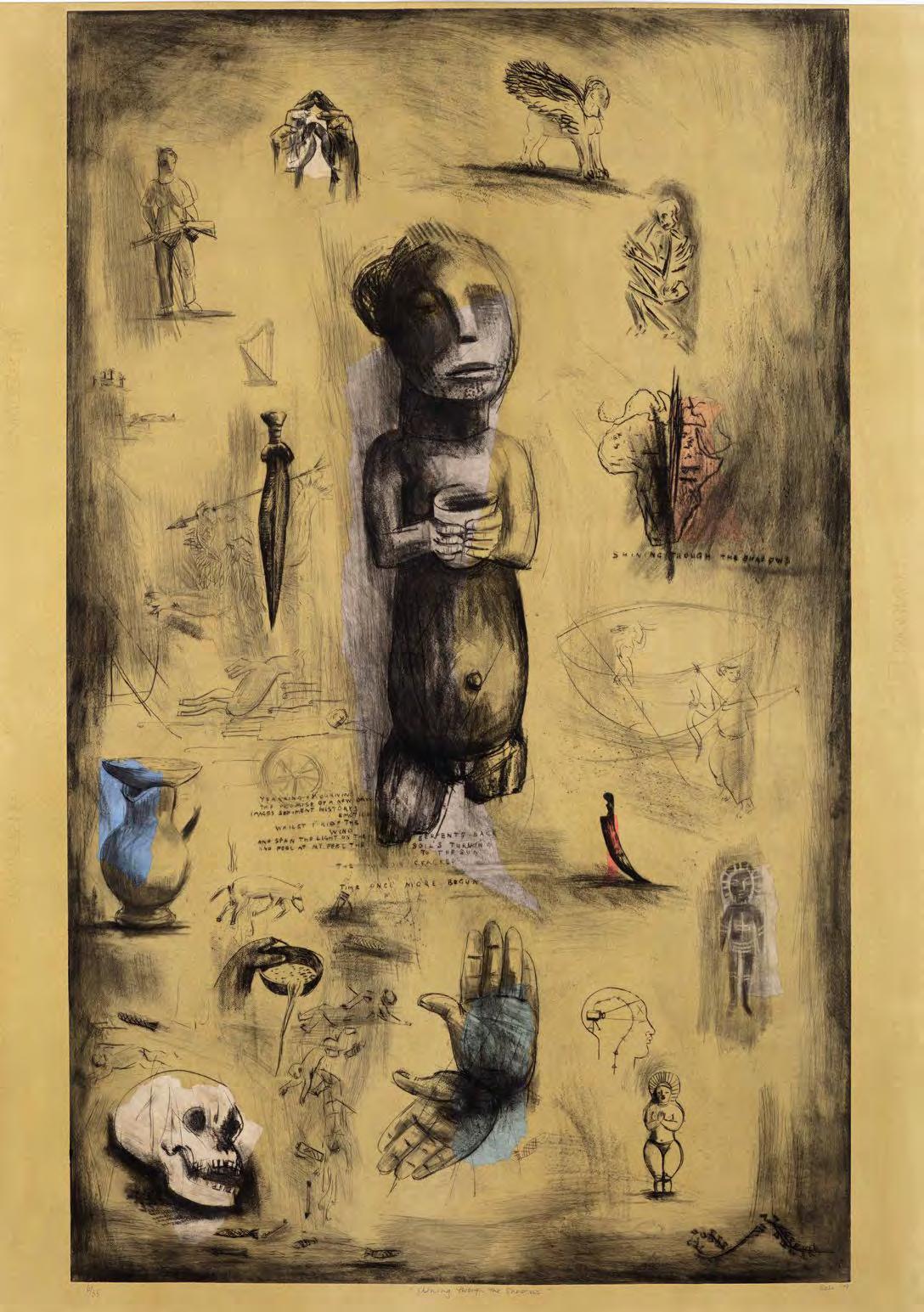
South African 1929–2014
Lament 2001
R5 000 – 10 000
linocut with colour screenprint signed, dated, numbered 24/30, inscribed with the title in pencil in the margin and embossed with The Caversham Press chop mark image size: 55 x 43 cm; sheet size: 63 x 48 cm

R5 000 – 10 000
linocut with colour screenprint signed, dated, numbered 24/25, inscribed with the title in pencil in the margin and embossed with The Caversham Press chop mark image size: 55 x 43 cm; sheet size: 63 x 48 cm
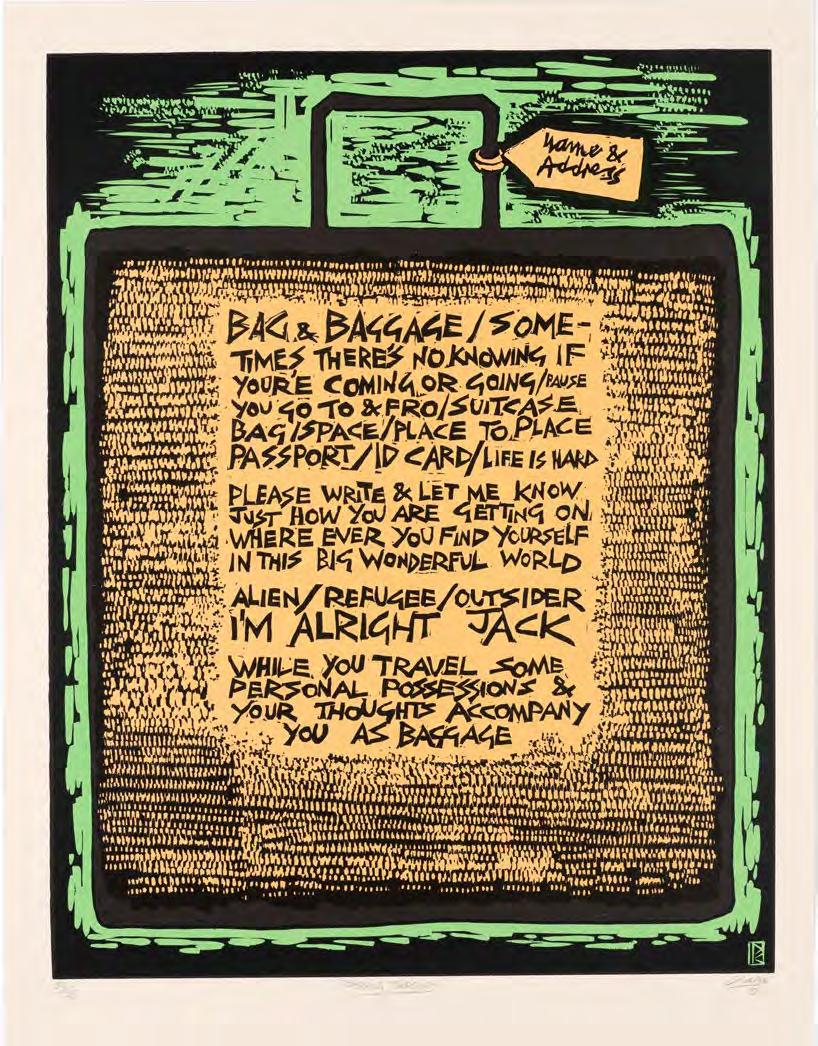
11
Marion Arnold
b.1947 South Africa
This Turbulent Land
R4 000 – 8 000 colour screenprint signed, dated, numbered 24/45, inscribed with the title in pencil in the margin and embossed with The Caversham Press chop mark image size: 40 x 57 cm; sheet size: 50 x 66 cm

12
Marion Arnold
b.1947 South Africa
Arbore Encore I 1991
R3 000 – 5 000
colour screenprint signed, dated, numbered 25/25, inscribed with the title in pencil in the margin and embossed with The Caversham Press chop mark image size: 15 x 58.5 cm; sheet size: 25 x 65.5 cm
13
Marion Arnold
b.1947 South Africa
Arbore Encore II 1991
R3 000 – 5 000
colour screenprint signed, dated, numbered 25/25, inscribed with the title in pencil in the margin and embossed with The Caversham Press chop mark image size: 15 x 58.5 cm; sheet size: 25 x 65.5 cm
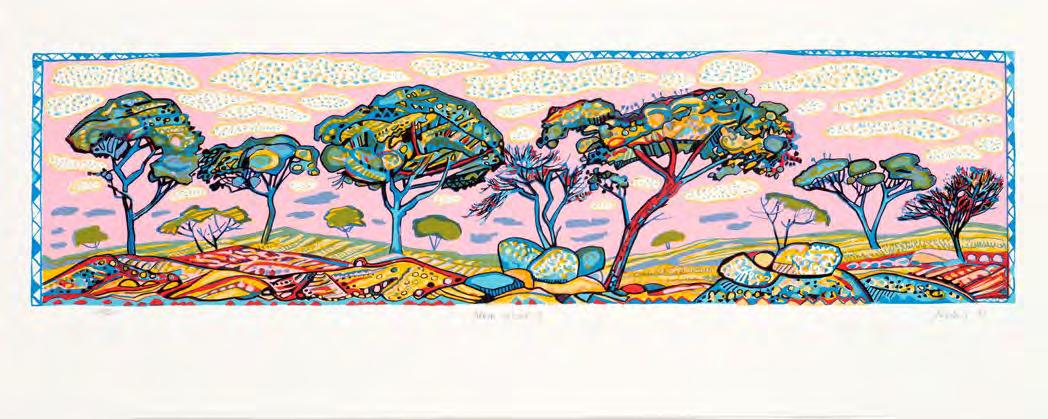

South African 1938–2019
Night Shift I, II, III, IV and V, set of five prints

2008
R15 000 – 25 000
etchings with drypoint each signed, dated, numbered 17/30, inscribed with the respective title in pencil in the margin and embossed with The Caversham Press chop mark

image size: 10 x 45 cm each; sheet size: 27 x 54 cm each
These panoramic cityscapes are quintessential examples of David Koloane’s expressive work chronicling black urban life in South Africa.
Compositionally frantic, the gritty images are filled with the artist’s go-to iconography. Motor vehicles move between traffic lights, amongst people, stray dogs and high-rise buildings as they make the daily commute from the township to the city, under the light of the ominous Johannesburg moon.
Koloane was recently recognized with a retrospective exhibition, Chronicles of a Resilient Visionary which travelled the country throughout 2019.



b.1953 South Africa
Plates Full 1999
R6 000 – 10 000
colour screenprint signed, dated, numbered 23/35, inscribed with the title in pencil in the margin and embossed with The Caversham Press chop mark image size: 90 x 60 cm; sheet size: 100 x 70 cm

16
b.1953 South Africa
Agapanthus 1992
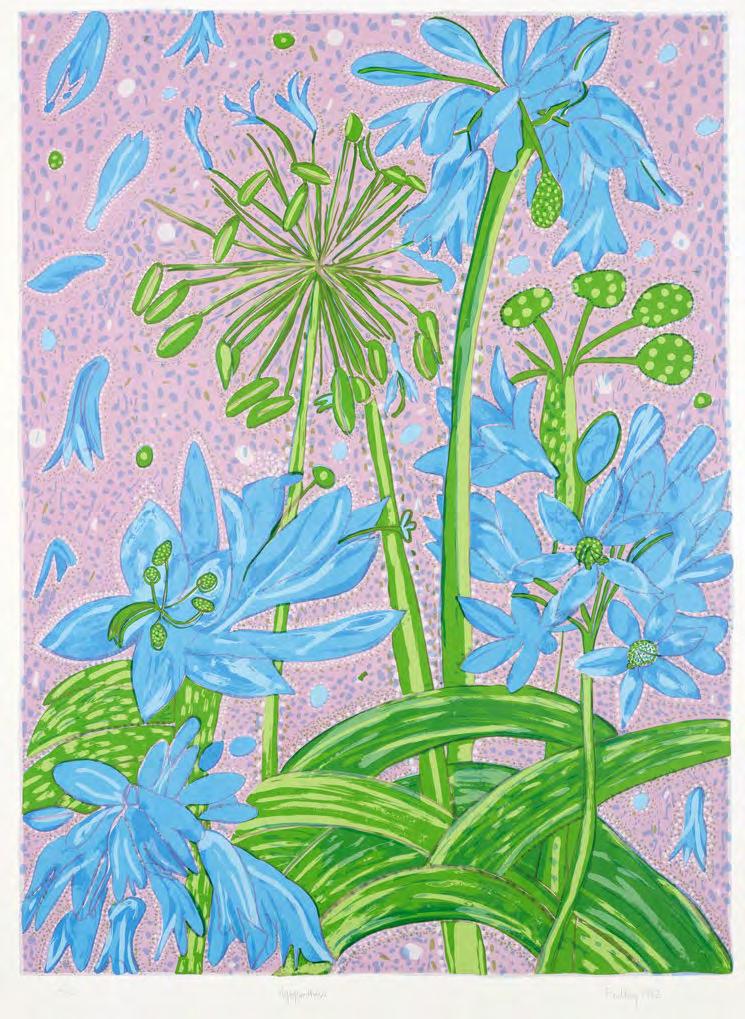
R6 000 – 10 000
colour screenprint signed, dated, numbered 16/45 and inscribed with the title in pencil in the margin and embossed with The Caversham Press chop mark image size: 75 x 55 cm; sheet size: 90 x 68 cm
17

South African 1920–2010
Happy Birthday, Mr Chairman! 1999
R20 000 – 30 000
colour screenprint signed, dated, numbered 41/45 in pencil in the margin, printed with the title in the plate and embossed with The Caversham Press chop mark images size: 37 x 61 cm; sheet size: 50 x 70 cm
1999
R25 000 – 35 000
colour screenprint signed, dated, numbered 40/45 in pencil in the margin, printed with the title in the plate and embossed with The Caversham Press chop mark image size: 65 x 65 cm; sheet size: 70 x 71 cm

19
William Kentridge

b.1955 South Africa
Ubu Niles Brutus, artist’s book 2017
R20 000 – 30 000
accordion-folded artist’s book with screenprint and letterpress in a linen slipcase signed in red conte, numbered 16/20 in pencil and printed with the date and ‘The Caversham Press’ on the back page slipcase: 13.2 x 16.5 x 0.8 cm

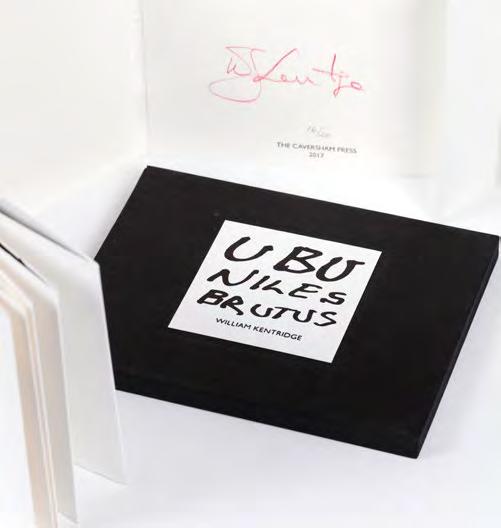
South African 1920–2010
Ubu: Limericks and Clerihews, artist’s book 1997
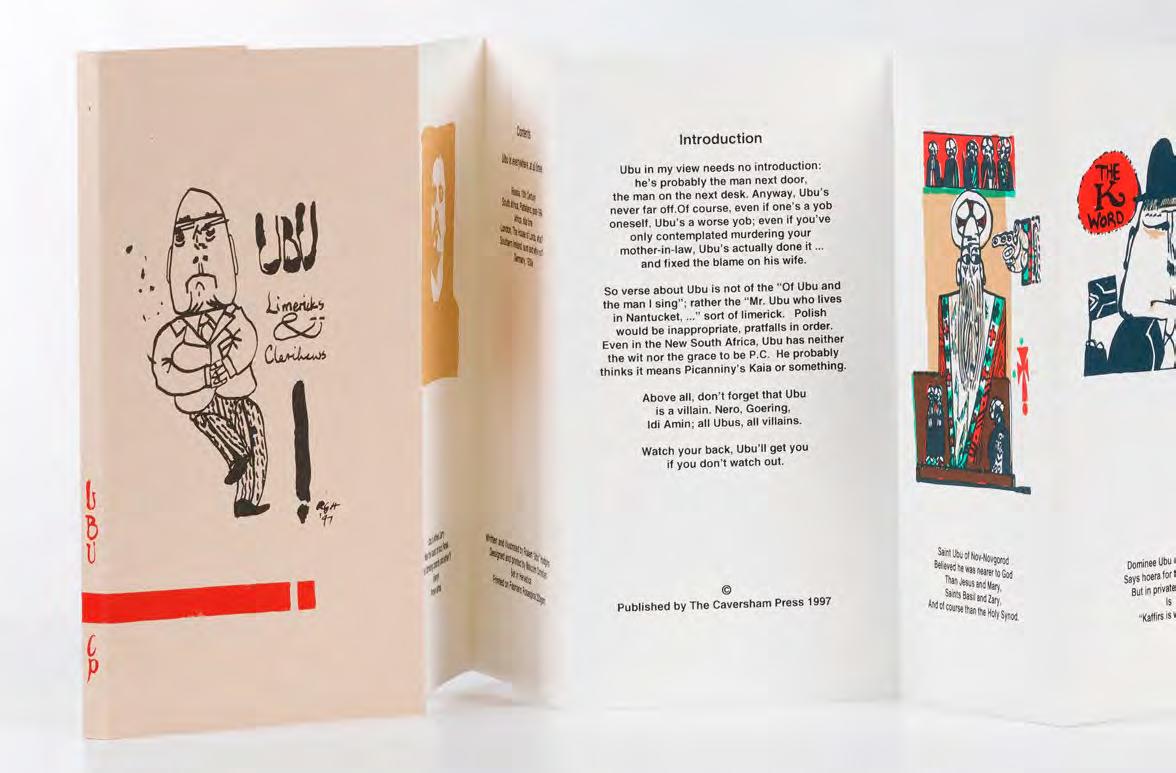
R15 000 – 20 000
accordion-folded artist’s book with colour screenprint numbered 8/75 in pencil on the frontis page; printed with the artist’s signature and date on the front cover closed: 25 x 14 cm

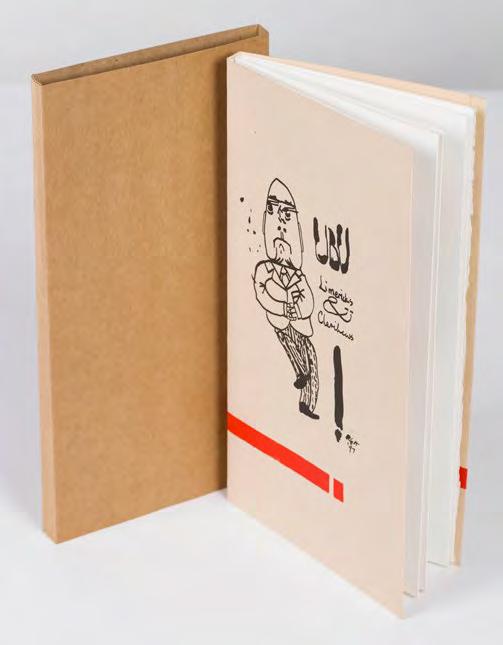
21
Mxolisi Nyezwa, Vusi Zwane and Simphiwe Cebekhulu
b.1967, 1957 and 1996 South Africa
Songs from The Earth, artist’s book
2016
R15 000 - 20 000
letterpress text with colour screenprint images, canvas cover with screenprint, hand-bound, in a custom slipcover numbered 12/75 closed: 31 x 16.5 x 3.5 cm



b.1955 South Africa
Felix in Exile (video cover) 1994 R35 000 – 45 000
colour screenprint signed twice, numbered 7/10 in pencil in the margin, printed with the artist’s name and title in the plate and embossed with The Caversham Press chop mark sheet size: 25 x 29 cm


Employing a wide range of printing techniques in a single work, William Kentridge displays his mastery of all the intaglio print media: the precision of etching, the velvety lines of soft ground, the direct mark-making of drypoint and the atmospheric effects of aquatint.
Key moments from one of Kentridge’s most powerful films, Felix in Exile, produced in 1994 – a pivotal time in South Africa’s transition to democracy –feature in this composite print. The top register opens with the artist alone in his hotel room surrounded by drawings. Acknowledging the Russian avantgarde, this room is drawn from a famous photograph of the radical display of paintings by Malevich and other artists in the so-called Last Futurist Exhibition in Petrograd in 1915/16.
In the middle register bodies, covered in newspapers and drawings, lie across landscapes defined by surveyors’ marks while Nandi clasps her head and weeps. Finally, between images of an abandoned drive-in cinema and the mining and industrial wasteland of the Witwatersrand, Nandi uses measuring devices to record the evidence of violence so that it will not be forgotten.
As Carolyn Christov-Bakargiev explains: ‘Nandi begins to draw; beacons or markers rise up from the ground. This process of drawing could be read as a metaphor for the attempt to reconstruct a post-colonial and postapartheid identity through memory and awareness of colonialism, violence and racism, rather than through erasure. In charting the landscape, Nandi is reappropriating the tools that were once used to dominate the terrain, in an active attempt to map new histories and geographies, a ‘new’ South Africa.’ 1
It is both Kentridge’s printmaking skills and his extraordinary ability to provide insight into a rapidly changing world that make works such as these so sought-after.
1 Christov-Bakargiev, C. (1998). William Kentridge. Brussels: Societé des Expositions du Palais des Bruxelles, p. 90.
23 William Kentridge b.1955 South Africa
Untitled (Felix in Exile) 1994
R350 000 – 450 000 etching with drypoint signed, numbered 34/35 in pencil in the margin and embossed with The Caversham Press chop mark image size: 55 x 78 cm; sheet size: 70 x 100 cm
Law-Viljoen, B. (2006). William Kentridge Prints. Johannesburg: David Krut Publishing, another example from the edition illustrated in colour on pp.50-51.
Knight, N. (2017). The Big Picture: an Art-O-Biography. Johannesburg: Natalie Knight Productions, illustrated on p.94.
Hecker, J. (2010). William Kentridge Trace. New York: The Museum of Modern Art, another example from the edition illustrated in colour on p.13.
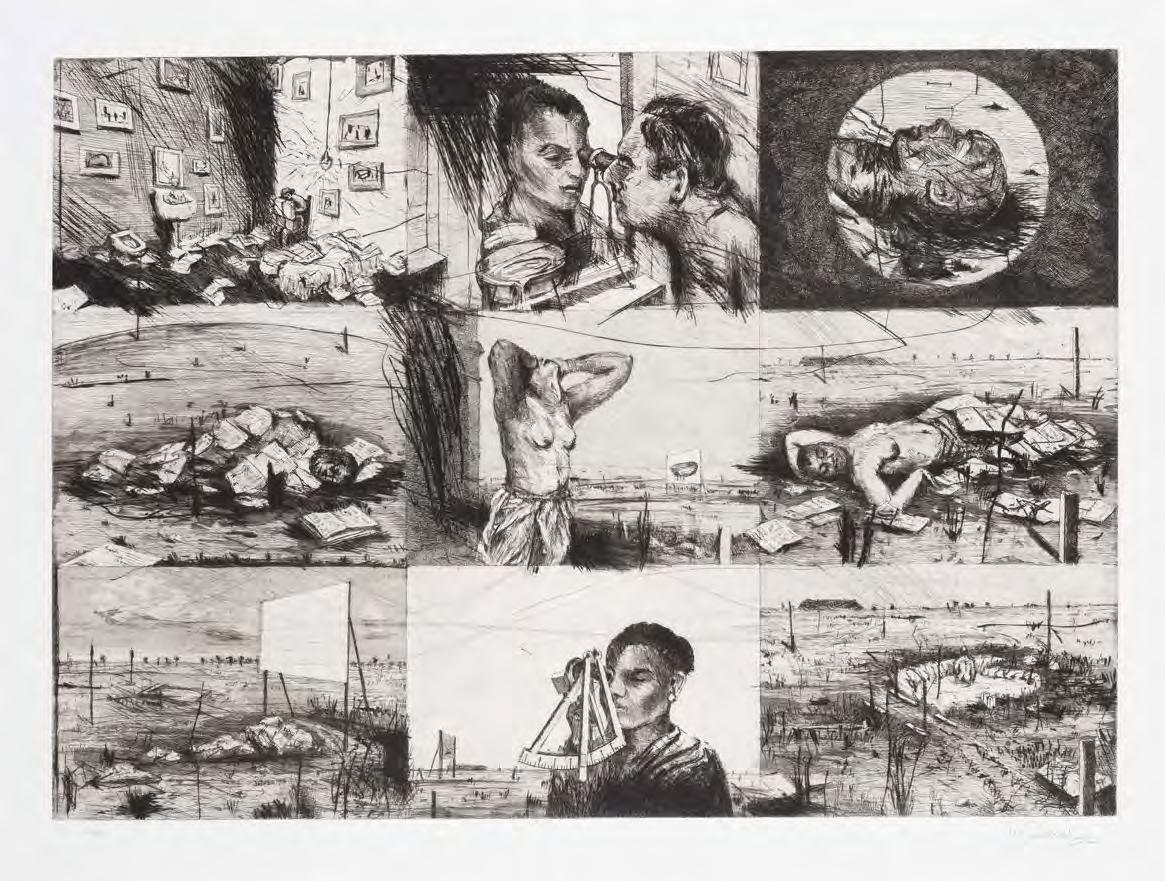

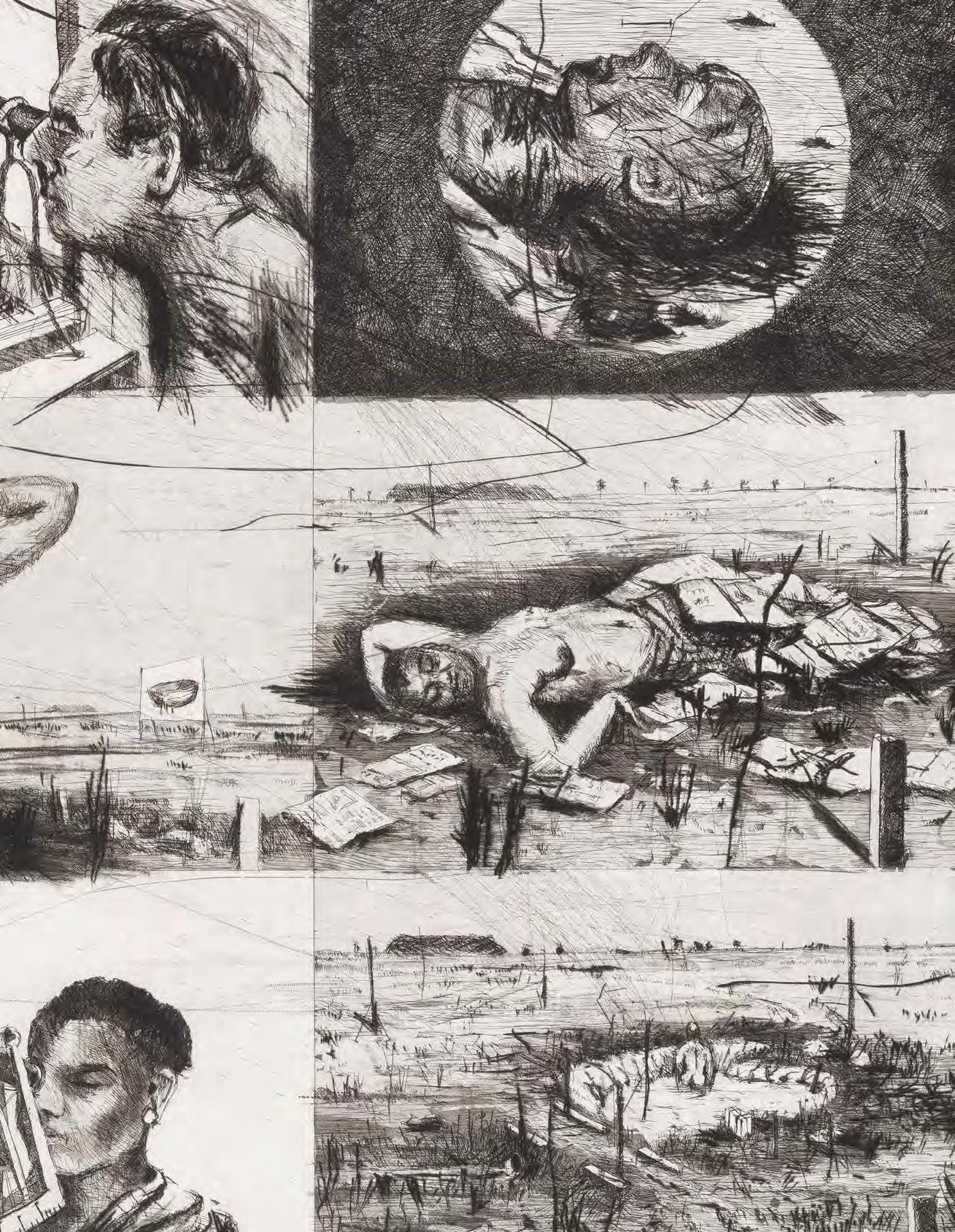
24
Norman Catherine b.1949 South AfricaZombi (sic) 1992
R10 000 – 20 000
hand-coloured stone lithograph signed, dated, numbered 8/45, inscribed with the title in pencil in the margin and embossed with The Caversham Press chop mark image size: 36 x 29 cm; sheet size: 66 x 50 cm
Possessing a distinct style synonymous with his name, Catherine’s creations have found their expression in various media, including painting, sculpture, mixed media, printmaking, wall hangings and bronze. His work fabricates intricate articulations of his inner psyche which plays host to a dystopian socio-political landscape uniquely his own. One would be hard pressed to assign a particular genre to Catherine’s work, especially as these find their inspiration from a host of stimuli – such as history, horror, crime, conflict and psychoses, amongst others. Catherine’s work forms part of the collections of the Museum of Modern Art and the Brooklyn Museum and are also included in major South African museums and collections.

25
Simphiwe Cebekhulu b.1996 South AfricaPreparation and Flow of Life, a pair 2015
R3 000 – 6 000 linocuts
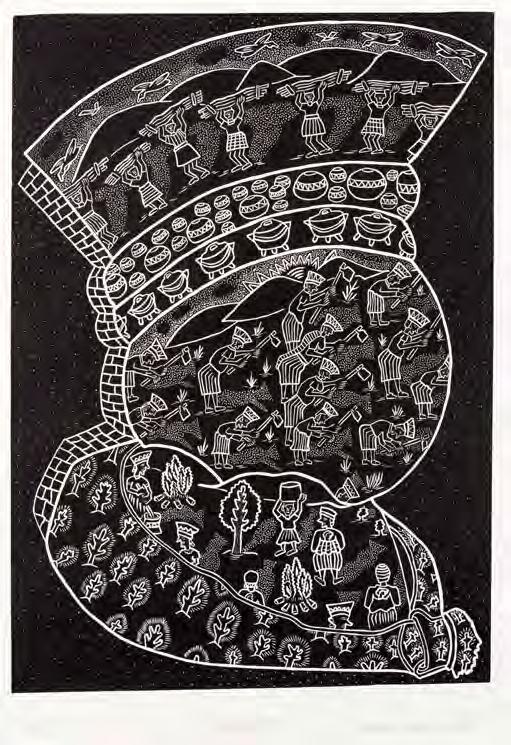
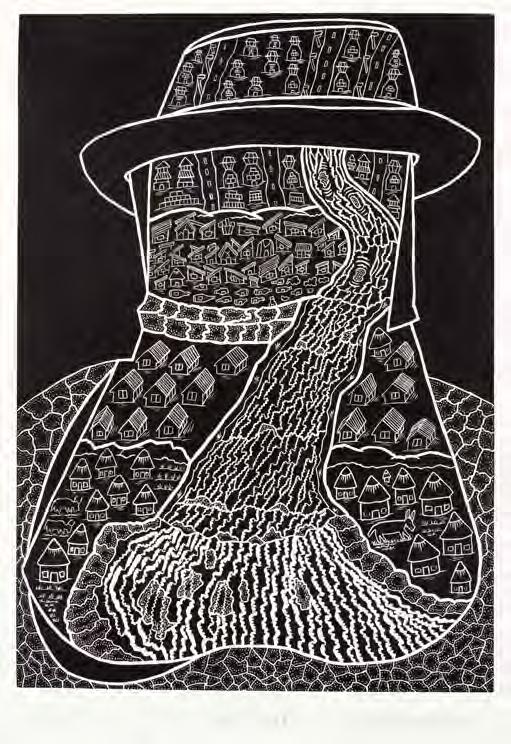
each signed, dated, numbered 6/30, inscribed with the respective title in pencil in the margin and embossed with The Caversham Press chop mark
image size: 51 x 36 cm each; sheet size: 65 x 48 cm each
Endlini yokulala yakithi (In our bedroom)
2001
R5 000 – 10 000
hand-coloured linocut signed, dated, numbered 22/30, inscribed with the title in pencil in the margin and embossed with The Caversham Press chop mark image size: 40 x 56 cm; sheet size 48 x 63.5 cm
Gabisile Nkosi was an artist and activist who worked to raise awareness of domestic and gender-based violence. Having been trained as a master printmaker under Malcolm Christian at the Caversham Press, Nkosi was also responsible for developing the Press’ various community-based programmes.
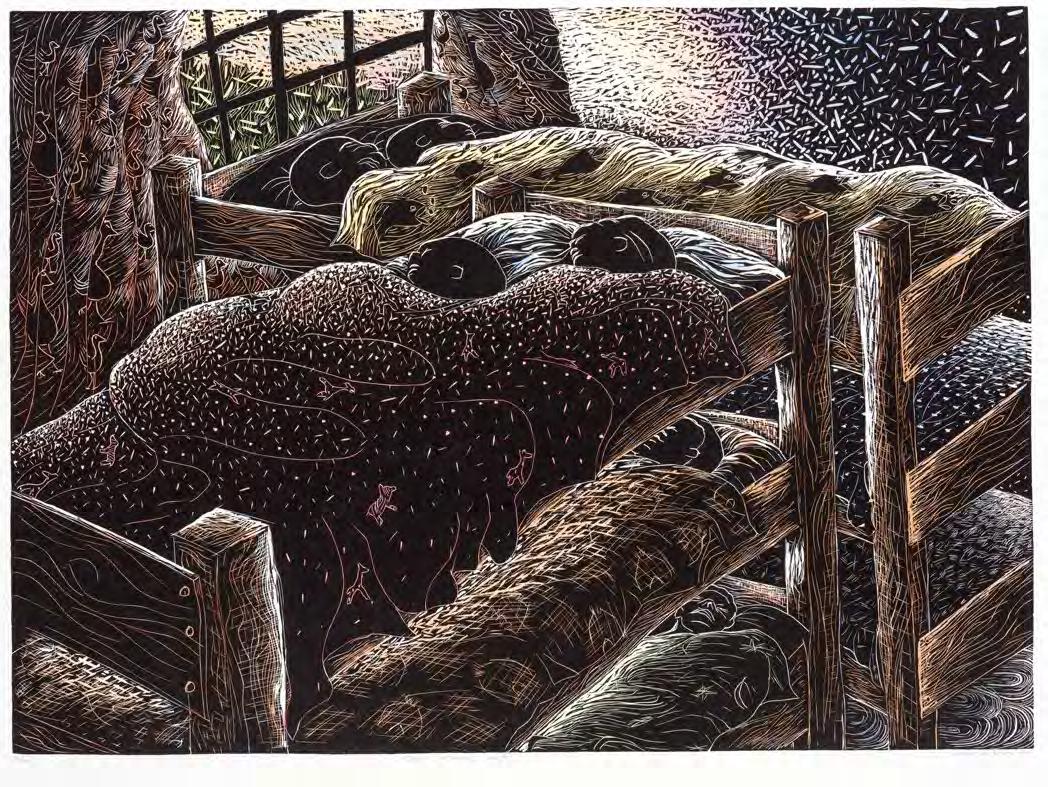
Healing portfolio, set of six prints
2007
R15 000 – 25 000 linocuts
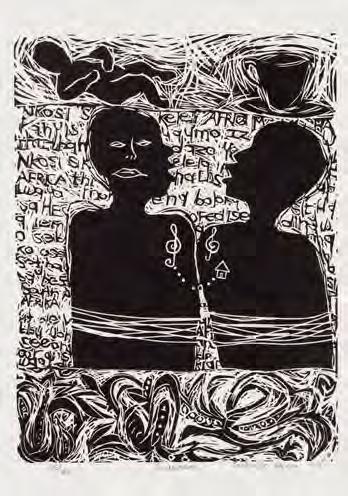
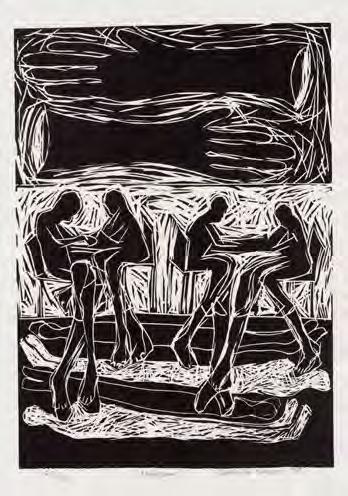
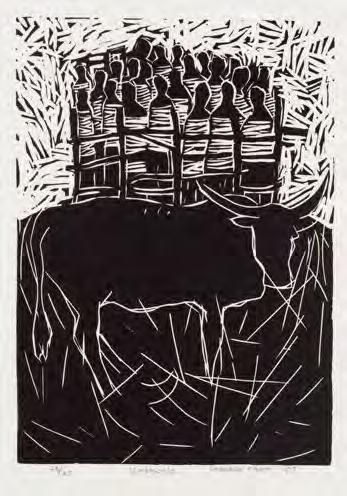



each signed, dated, numbered 24/45, inscribed with the respective title in pencil in the margin and embossed with The Caversham Press chop mark image size: 21 x 15 cm each; sheet size: 144.5 x 33 cm each
Print titles: Culanami (Sing with me), Isizululwane (Generations), Ongaphansi Nongaphezulu (Ups and Downs), Umthwalo (Baggage), Ungubani (Who are you?) and Uxolo (Peace).
Gabi was invited to produce an exhibition to celebrate the 200th Anniversary of the Abolition of Slavery in the UK. These prints were part of this exhibition.
In her own practice, Nkosi maintained an element of playfulness, whilst addressing more violent themes. The Healing portfolio was featured in a collaborative exhibition, Ukwelapa (Healing) which showed at the African Art Centre, Durban during Woman’s month, August 2007. In a cruel twist of fate, this would be the artist’s last exhibition before she was tragically murdered in her home by an ex-boyfriend the next year.
Nkosi’s legacy lives on; in 2017, the Healing portfolio was included in MTN’s Activism and Awareness exhibition in Durban, her work is also included in the permanent collection of MOMA, New York.
28
Mmakgabo Mmapula Mmangankato Helen Sebidi b.1943 South Africa
Like A Dream 1991 R4 000 – 8 000 etching signed, dated, numbered 6/30, inscribed with the title in pencil in the margin and embossed with The Caversham Press chop mark image size: 25 x 20 cm; sheet size: 60 x 50 cm

1996
R6 000 – 10 000 etching signed, dated, numbered 18/45, inscribed with the title in pencil in the margin and embossed with The Caversham Press chop mark image size: 45 x 30 cm; sheet size: 64 x 50 cm
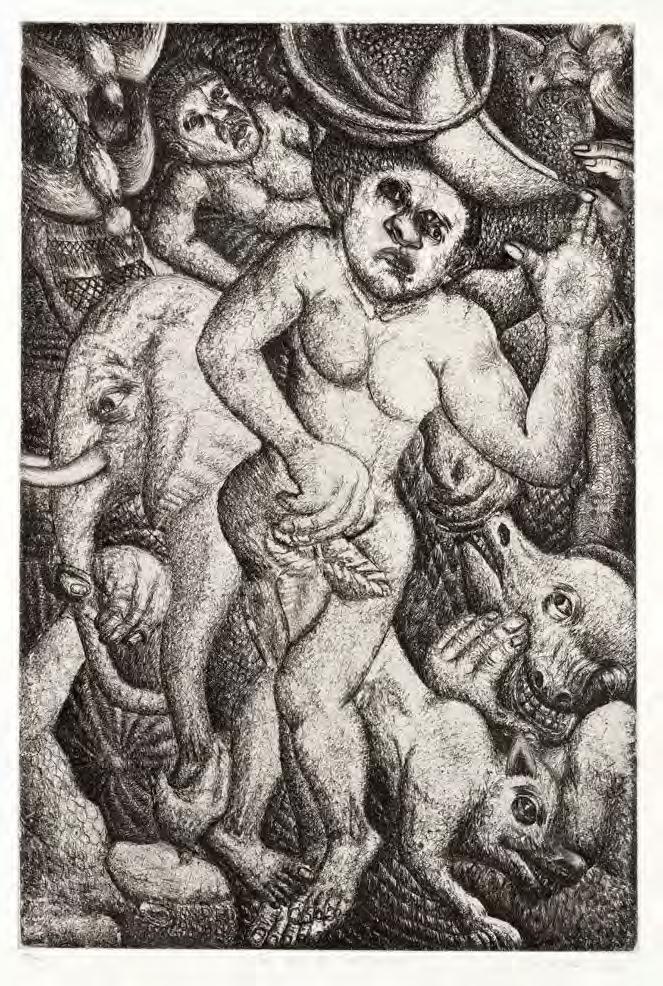
Deborah Bell
b.1957 South Africa
Ma Ubu I, II, III & IV, set of four prints
plate dated 1997, printed in 2011
R55 000 – 65 000 etchings with drypoint each signed, dated, numbered 33/45, inscribed with the respective title in pencil in the margin and embossed with The Caversham Press chop mark image size: 25 x 30 cm each; sheet size: 39 x 54 cm each

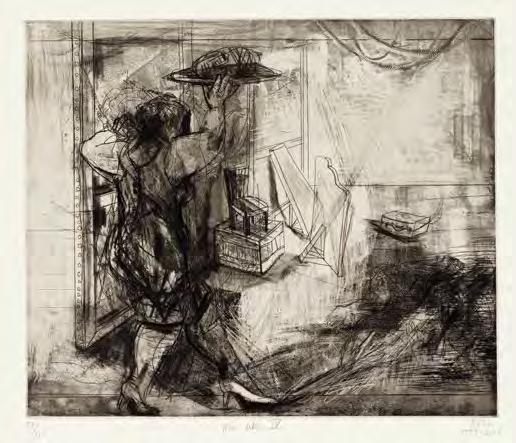

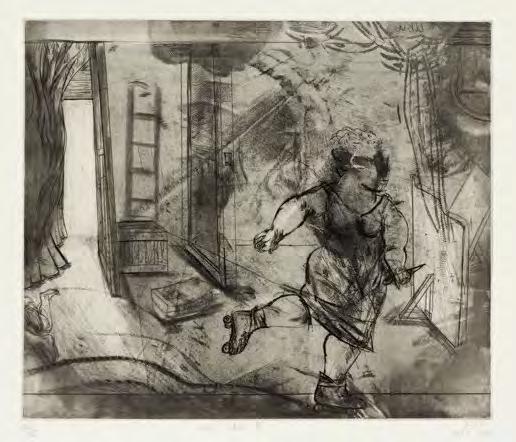

31
The Wedding 1991
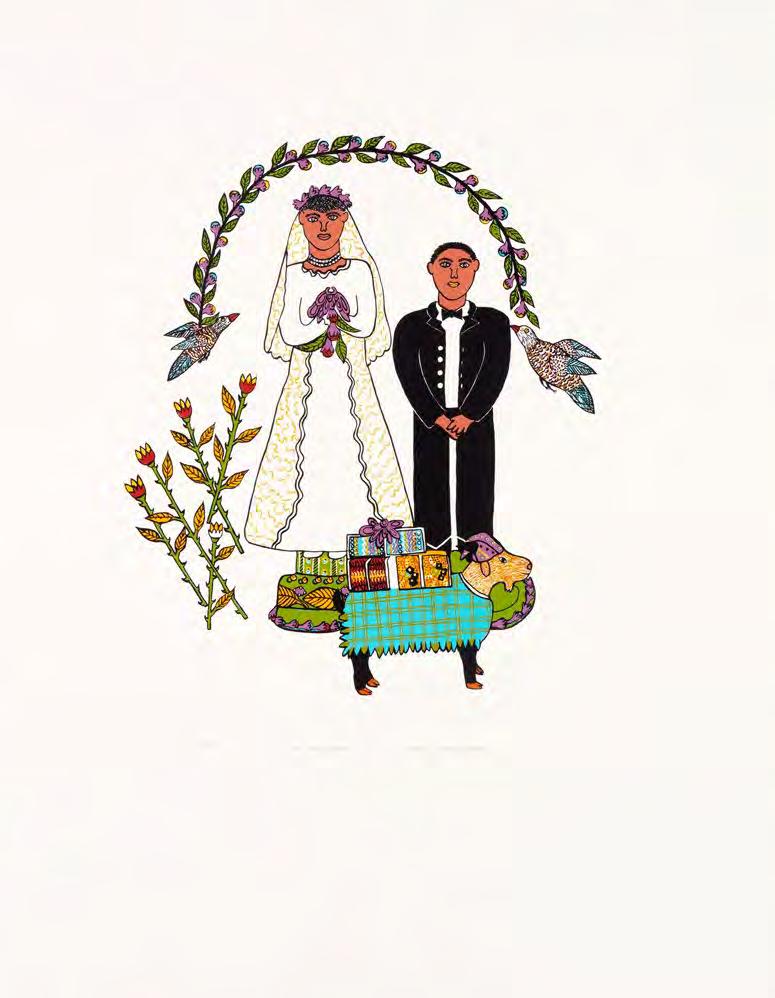
R3 000 – 6 000
colour screenprint signed, dated, numbered 42/50, inscribed with the title in pencil in the margin and embossed with The Caversham Press chop mark image size: 33 x 28 cm; sheet size: 66 x 50 cm

Joseph and Elijah, a pair 1991
R5 000 – 10 000
colour screenprints each signed, dated, numbered 39/40, inscribed with the respective titles in pencil in the margin and embossed with The Caversham Press chop mark images size: 32 x 28 cm each; sheet size: 66 x 50 cm each
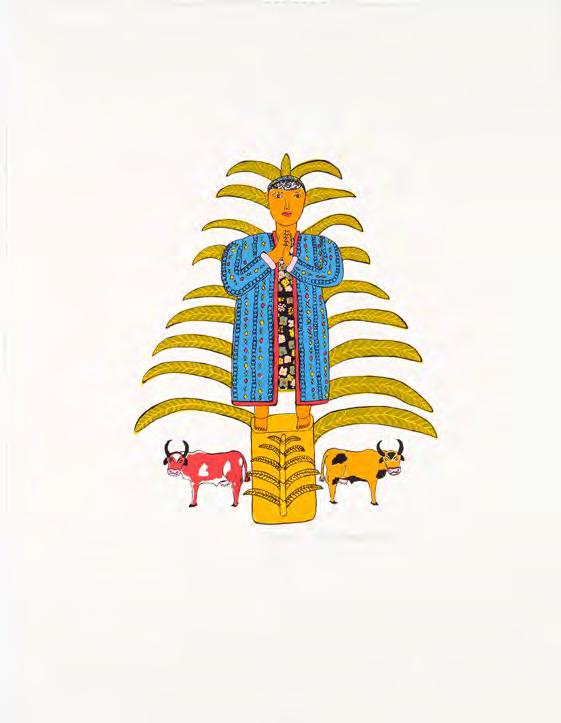
33
William Kentridge
b.1955 South Africa
Untitled (Back Flip) 1991
R35 000 – 45 000 stone lithograph signed, numbered 17/17 in pencil in the margin and embossed with The Caversham Press chop mark sheet size: 38 x 38 cm
William Kentridge’s Drawings for Projections feature two polarising protagonists, Felix Teitlebaum and Soho Eckstein. Soho is typically presented in his iconic pinstriped suit, and Felix naked. Through the development of these characters, Kentridge conveys an empathy for and relation to these men. Soho, a man of distorted white capitalistic rationality who comprised his humanity for it, and then Felix whose life is passion and vulnerability; these two contradicting men seem to be halves of the same individual.
In Untitled (Back Flip) we have the same complex and honest duality of being, the elevated naked whim, the compressed heavy capitalist below next to a puddle of water, both reflection and life. Kentridge manages to portray the experience of current society and its contradicting nature.
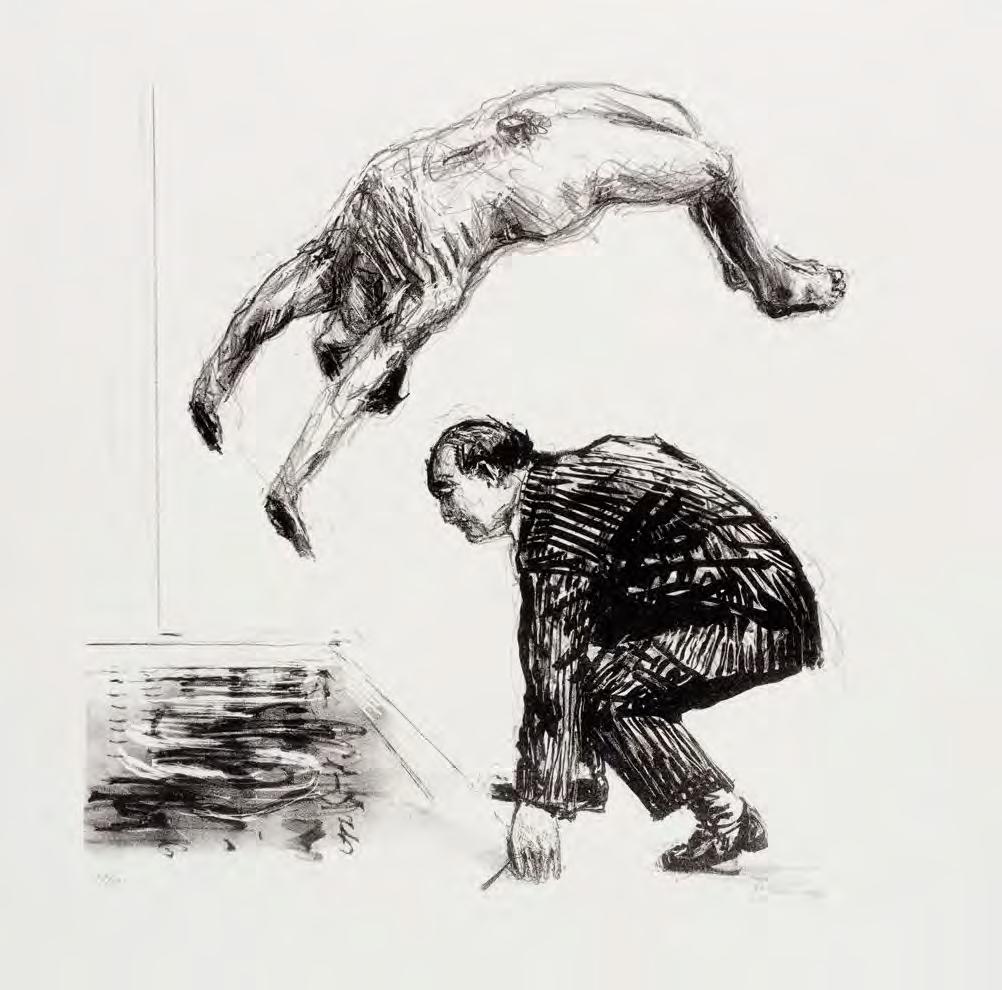
34
South African 1920–2010
I Say, Old Chap! 1999/2000
R25 000 – 35 000
stone lithograph with colour screenprint signed, dated, numbered 30/30 in pencil in the margin, printed with the title in the plate and embossed with The Caversham Press chop mark sheet size: 50 x 70 cm
Buys, A. (2012). A Lasting Impression: The Robert Hodgins Archive. Johannesburg: Wits Art Museum another example from the edition illustrated in colour on the cover.
As we have come to know and love, Robert Hodgins titles are an integral part of his practice, more so with his prints than with his painting as the latter were usually titled on the reverse. Hodgins used the titles as a punchline of humour, to reveal an antidote which was in most part to ‘parody’ the rigid performance of British gentlemanship or the Military complex.
I Say, Old Chap!, the title exclaims as two suit wearing gentlemen gaze upon a seated nude woman. Humorously mocking the now aged and irrelevant act of portraying idealistic nude woman for the consumption and gaze for well-dressed men.
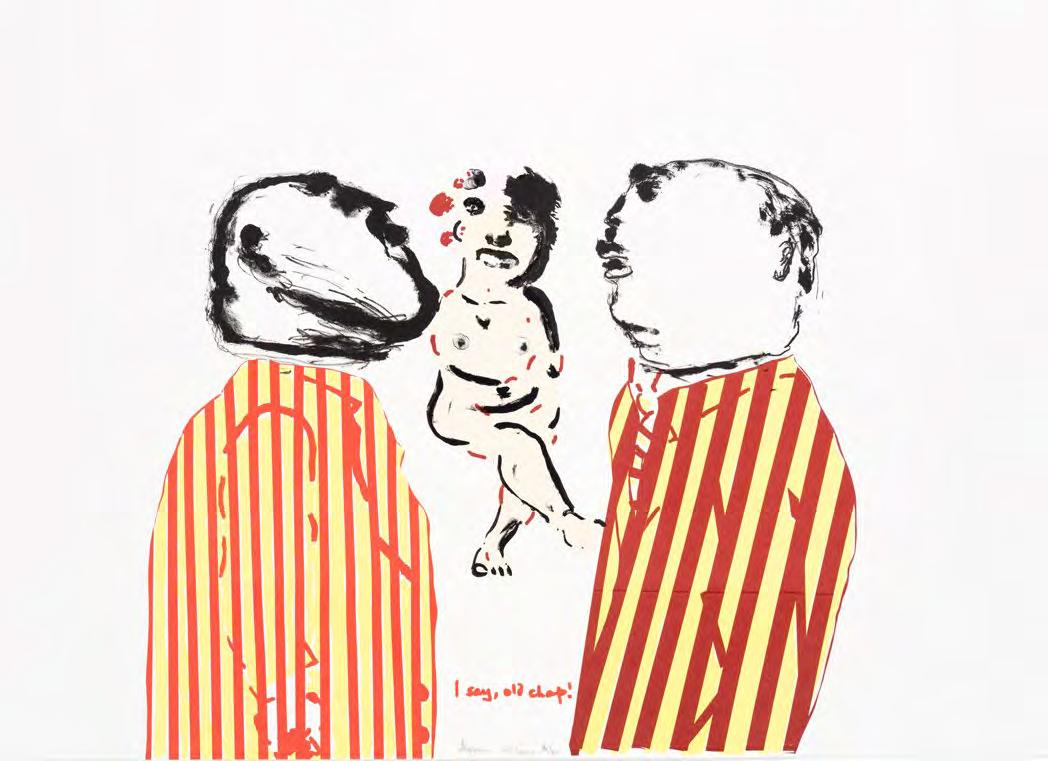
Tailor Made... 1996
R35 000 – 45 000
colour screenprint signed, dated, numbered 15/25 in pencil in the margin, printed with the title in the plate and embossed with The Caversham Press chop mark image size: 76 x 62 cm; sheet size: 102 x 85 cm
Buys, A. (2012). A Lasting Impression: The Robert Hodgins Archive. Johannesburg: Wits Art Museum another example from the edition illustrated in colour on p.246.
Known for satirizing figures of power, especially malicious businessmen dressed in pinstripe power suits, Hodgins’ unique sense of portraying figures in uncanny compositions amidst a scene of graphic lines and animated colours have become iconic trademarks of his output. Adding to the greater movement amongst artists of the 1980s in their attempts to produce unique styles, make anti-apartheid statements and deliver social commentary through their work, it was Hodgins’ expressionistic depictions of such figures that caught the attention of the Standard Bank National Arts Festival who presented a major retrospective exhibition of his works in 1986.
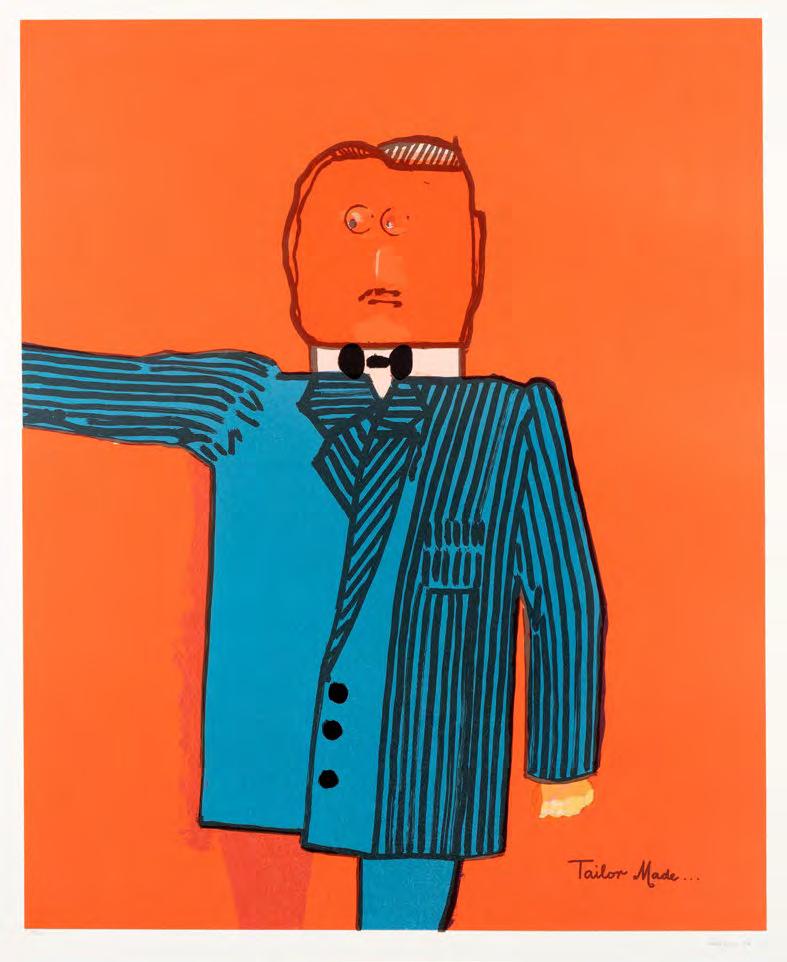
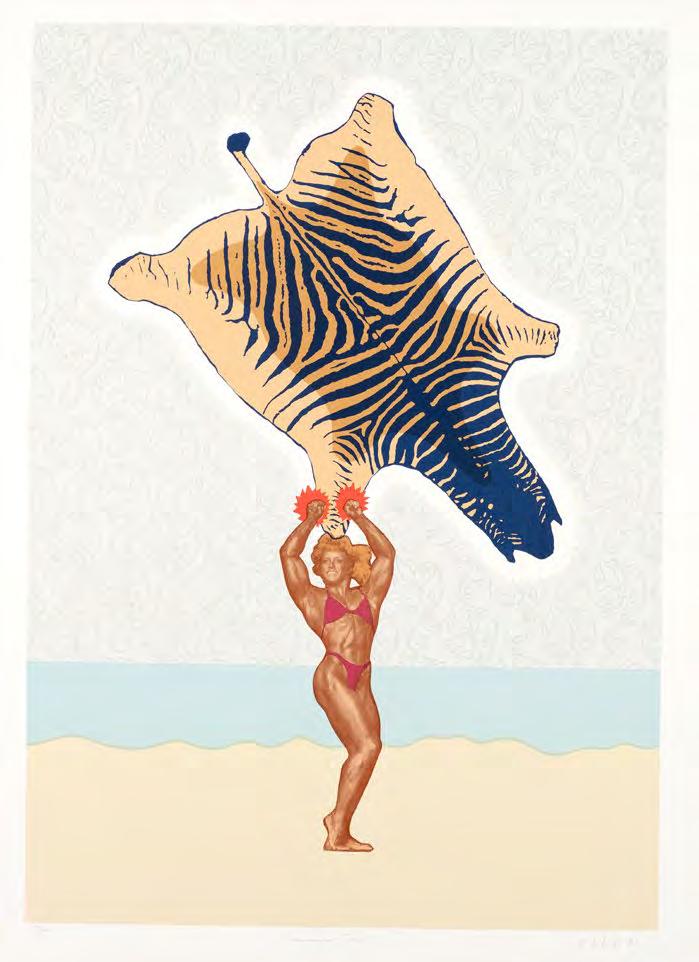
R8 000 – 15 000
colour screenprint signed, dated, numbered 12/14, inscribed with the title in pencil in the margin and embossed with The Caversham Press chop mark image size: 85 x 60 cm; sheet size: 108 x 79 cm
37
South African 1954-2012
Ah, But the Clouds 1990
R4 000 – 8 000
stone lithograph signed, dated, numbered 6/10, inscribed with the title in pencil in the margin and embossed with The Caversham Press chop mark image size: 16 x 7 cm; sheet size: 25 x 14 cm


Hobbs, P and Rankin, R. (1997). Printmaking in a Transforming South Africa. Cape Town: David Philip Publishers (Pty) Ltd, hand-coloured edition illustrated in colour on p.183.
38
South African 1954-2012
In Memorium: Samuel Beckett 1990
R4 000 – 8 000
stone lithograph signed, dated, numbered 6/10, inscribed with the title in pencil in the margin and embossed with The Caversham Press chop mark image size: 15 x 10 cm; sheet size: 25 x 18 cm
Untitled 1990
R4 000 – 8 000 stone lithograph signed, dated, numbered 6/10, inscribed with the title in pencil in the margin and embossed with The Caversham Press chop mark image size: 10 x 10 cm; sheet size: 25 x 18 cm
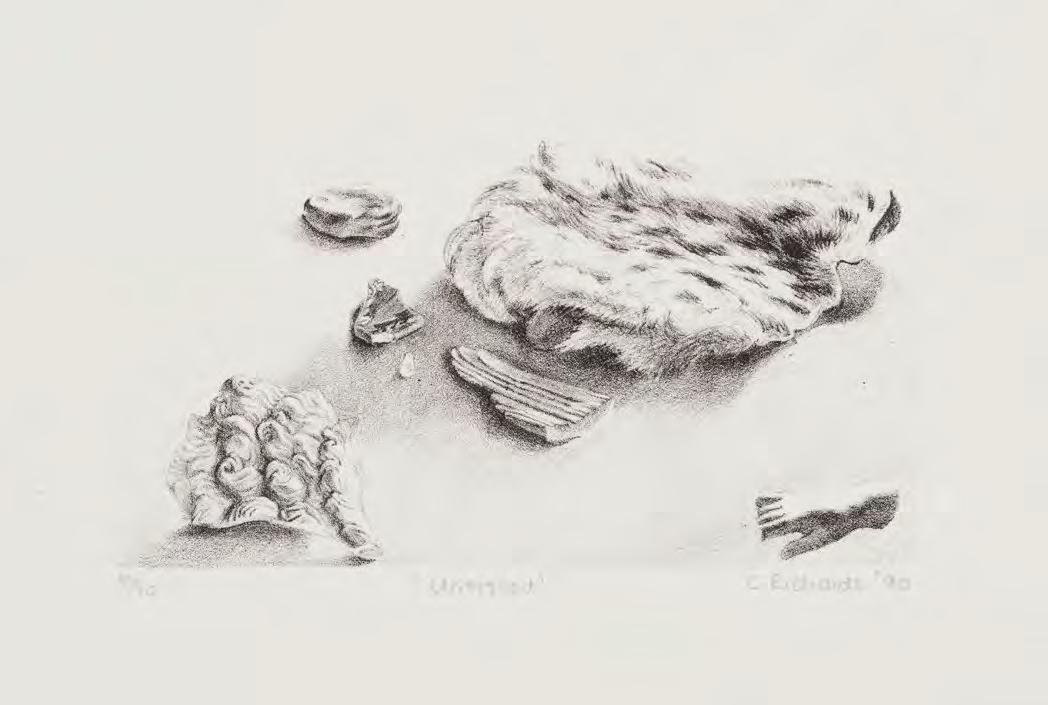
40
William Kentridge
b.1955 South Africa
Untitled (Woman with Mirror) 2000
R100 000 – 150 000
etching with drypoint signed, numbered 13/20 in pencil in the margin and embossed with The Caversham Press chop mark image size: 60 x 52 cm; sheet size: 80 x 70 cm
“The real function of the mirror was…. to make the woman connive in treating herself as, first and foremost, a sight.” 1
William Kentridge continues to flip art historical conventions on their head, from depicting dystopic lived landscapes in opposition of the idealistic landscapes, to using trompe l’oeil style of conveying bronze sculptures as paper and cardboard assemblages.
In Untitled (Woman with Mirror), a naked woman stands facing an obelisk like mirror, two shadows are cast, one on the mirror, one on the wall behind. The mirror is nothing like the handheld gilded mirrors of yester years, William creates a rock shard of a mirror, there is no reflection, the viewer is not allowed to participate in this self-inspection. The second shadow has no clear origin, is it the artist’s own fourth wall depiction? If so, is it to dull the voyeuristic nature of this work or to further complicate it? Whatever it is, it is clear that this is not a case of vanity but of introspection, of the subject and the artist.
1 Berger, J. (1972). Ways of Seeing. London: Penguin Books. p.51.
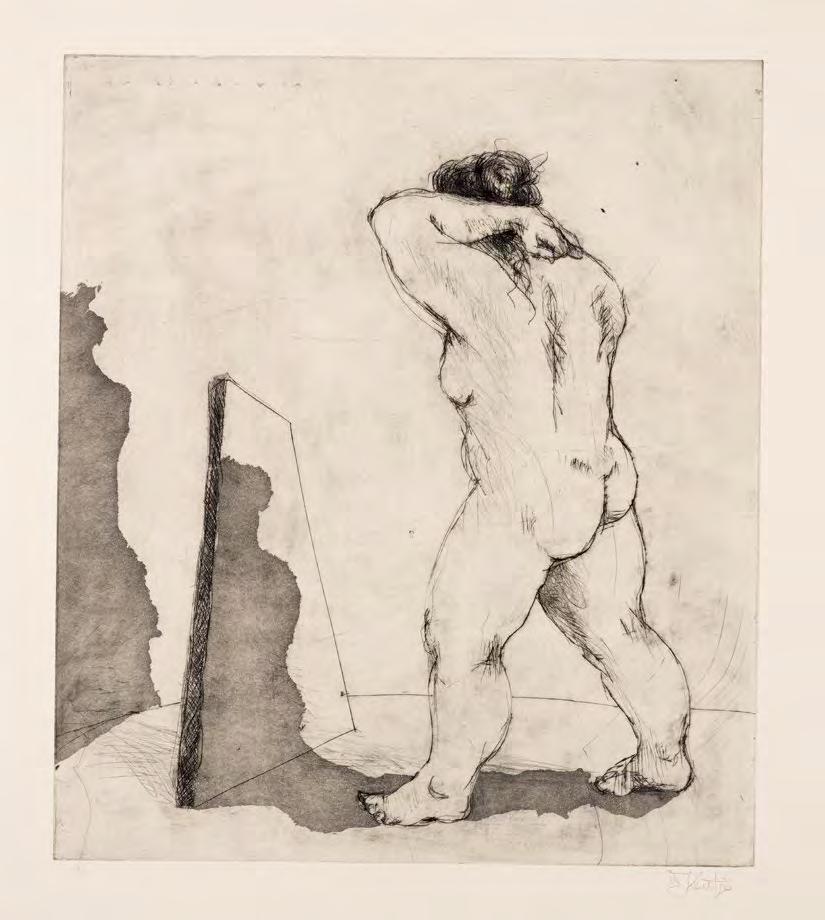

41
b.1976 South Africa
The Burning Hill 1996
R2 000 – 4 000
stone lithograph with colour screenprint signed, dated, numbered 18/60, inscribed with the title in pencil in the margin and embossed with The Caversham Press chop mark image size: 14 x 20 cm; sheet size: 22 x 30 cm
42
Sthembiso
b.1976 South Africa
Morning Meeting 1995
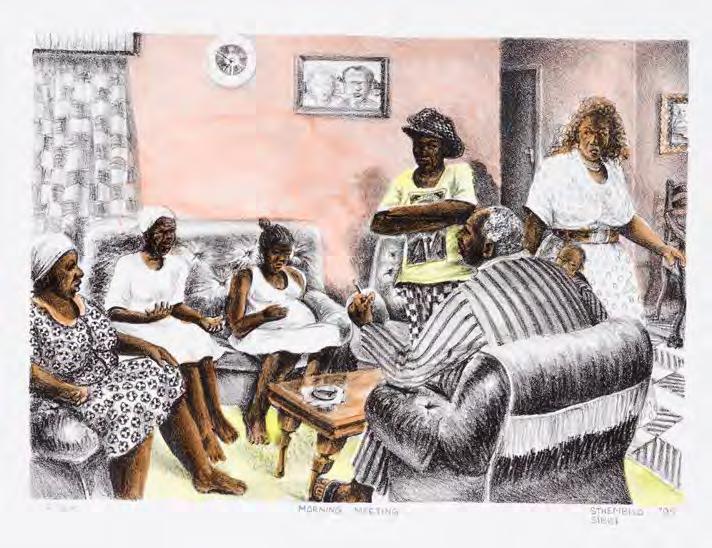
R4 000 – 8 000
hand-coloured stone lithograph signed, dated, numbered 13/25, inscribed with the title in pencil in the margin and embossed with The Caversham Press chop mark image size: 20 x 27 cm; sheet size: 35 x 50 cm
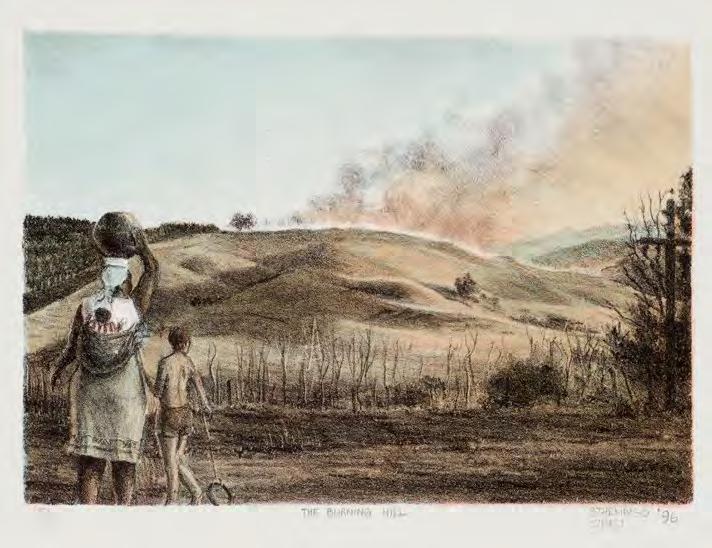
43
b.1966 South Africa
Card Gambling and Dice Gamblers, a pair 1997

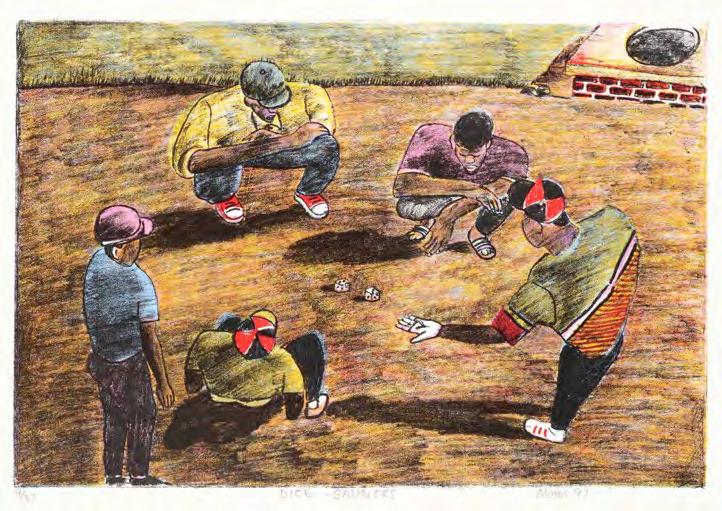
R3 000 – 6 000 colour screenprints each signed, dated, numbered 9/30, inscribed with the respective title in pencil in the margin and embossed with The Caversham Press chop mark
image size: 23 x 35 cm each; sheet size: 35 x 50 cm each
South African 1920–2010
Ubu Centenaire: Histoire d’un farceur criminel, set of eight prints
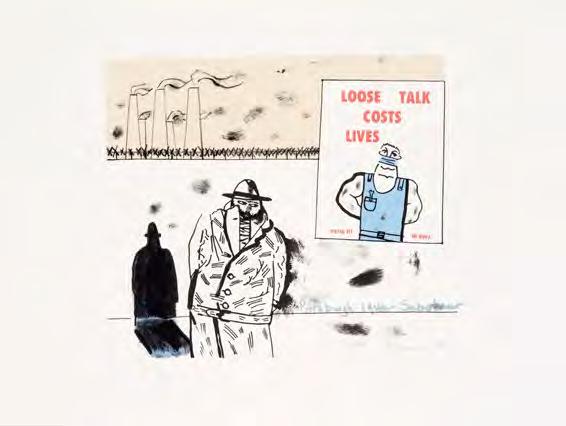
1996
R80 000 – 120 000 colour screenprints each signed, dated, numbered 46/50 in pencil in the margin, printed with the respective title in the plate and embossed with The Caversham Press chop mark image size: 27 x 30 cm each; sheet size: 35 x 50 cm each

Print titles: Rwanda? Afghanistan? Balkans? 1996, South Africa 197? - Interrogator, Paris - with FuhrerJune 1940, Berlin - Inflation - 1943, Central; Africa? East Africa? 1960s, Pittsburgh 1944 - Saboteur, MidAtlantic - Titanic - April 1912, France - The Dreyfus Affair - 1896...
Buys, A. (2012). A Lasting Impression: The Robert Hodgins Archive. Johannesburg: Wits Art Museum, examples from the edition illustrated in colour on pp.14, 17, 20, 82, 178, 184, 186, 190.


In 1896, Alfred Jarry opened his provocative, absurd and satirical play Ubu Roi, which loosely parodies Shakespeare’s Macbeth. The protagonist, a greedy king whose own avarice leads to his demise and defeat. Robert Hodgins uses Jarry’s play as a point of reference to wryly comment on the prior 100 years of arrogant and malevolent men abusing their power for personal opulence and disillusionment, while the public pays the cost. Hodgins’ wit shines through and makes a rather critical retrospection; palatable, funny and engaging. In this manner, the artist has fittingly celebrated Jarry’s style of absurd comic wild revelation in the Histoire d’un farceur criminel (History of a criminal prankster).




45 Marion Arnold b.1947 South Africa
Irma in a Mask Remembering 1995
R5 000 – 10 000 colour screenprint signed, dated, numbered 20/40, inscribed with the title in pencil in the margin and embossed with The Caversham Press chop mark image size: 43 x 60 cm; sheet size: 64 x 77 cm

46
Edith Bukani
20th Century South Africa
Strict Parents 1995
R800 – 1 200
colour screenprint signed, dated, numbered 20/45, inscribed with the title in pencil in the margin and embossed with The Caversham Press chop mark image size: 26 x 40 cm; sheet size: 38 x 57 cm
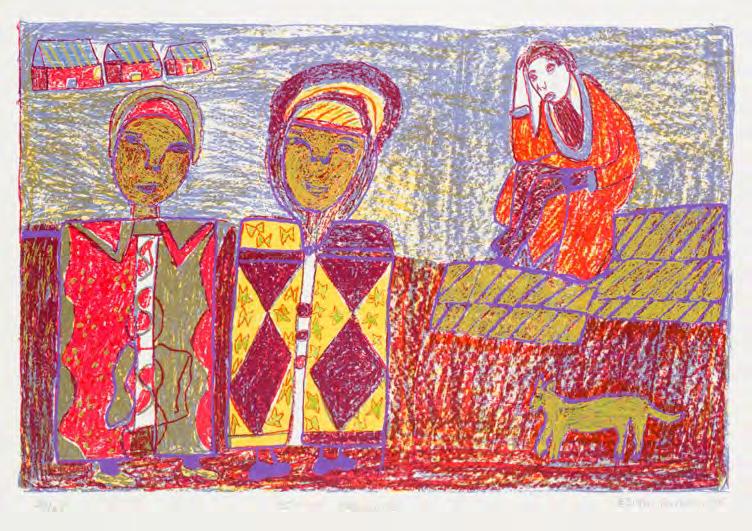
b.1972 United States of America
Untitled 2005
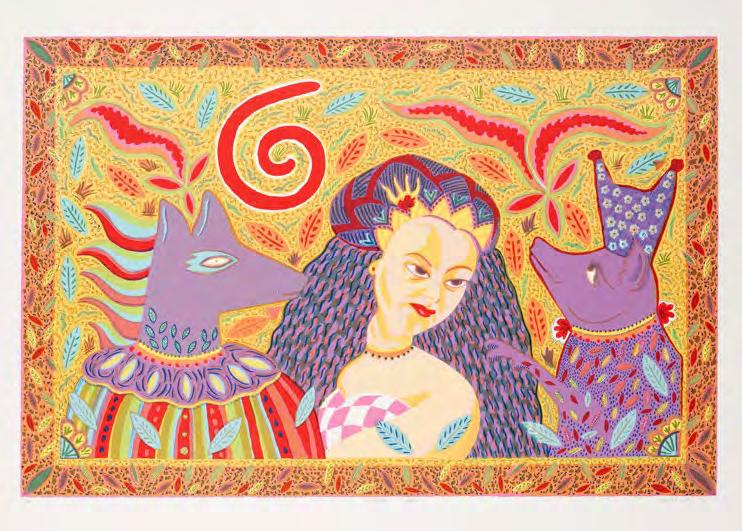
R4 000 – 8 000
colour screenprint signed, dated, numbered 29/36, inscribed with the title in pencil in the margin and embossed with The Caversham Press chop mark image size: 57 x 82 cm; sheet size: 70 x 100 cm
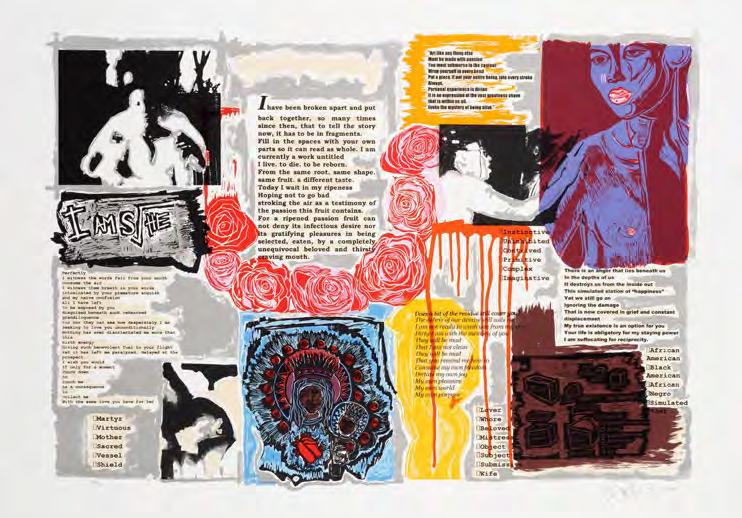
b.1953 South Africa
R6 000 – 10 000
colour screenprint signed, dated, numbered 12/14, inscribed with the title in pencil in the margin and embossed with The Caversham Press chop mark image size: 60 x 91 cm; sheet size: 79 x 108 cm
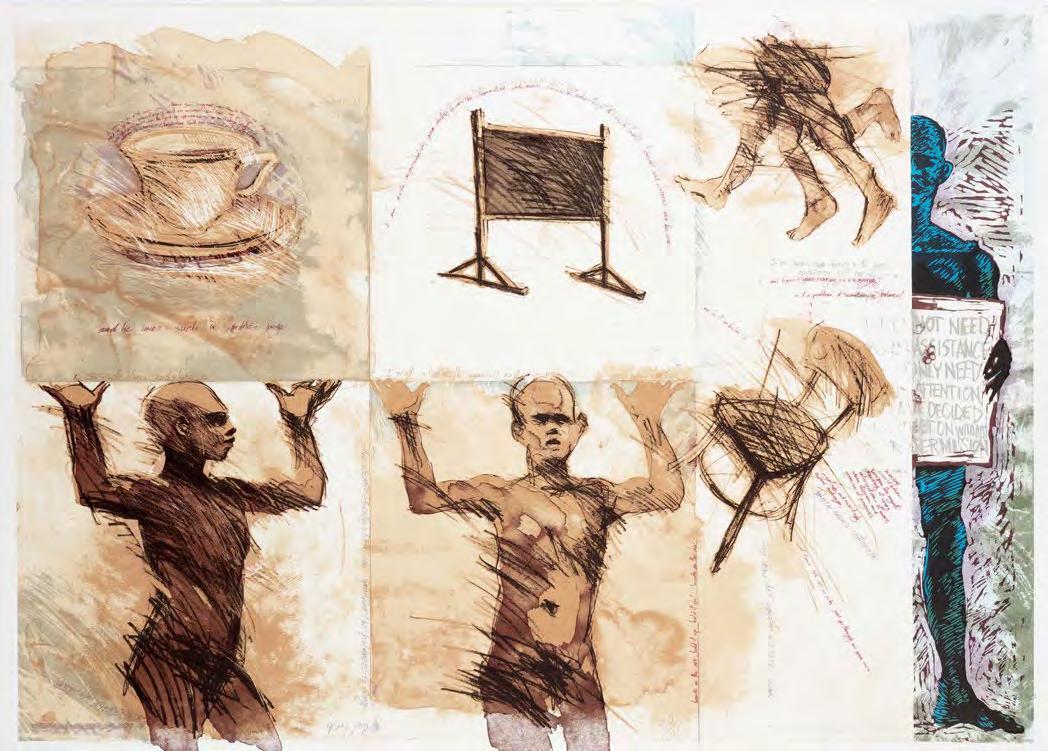 Christopher Cozier
Christopher Cozier
b.1959 Trinidad
Maintaining Balance 1999
R6 000 – 10 000 colour screenprint signed, dated, numbered 32/36, inscribed with the title in pencil in the margin and embossed with The Caversham Press chop mark sheet size: 70 x 100 cm
50
Christopher Cozier b.1959 TrinidadIntersection 1999
R4 000 – 8 000
linocut with colour screenprint signed, dated, numbered 51/60, inscribed with the title in pencil in the margin and embossed with The Caversham Press chop mark image size: 64 x 27 cm; sheet size: 70 x 45 cm

51
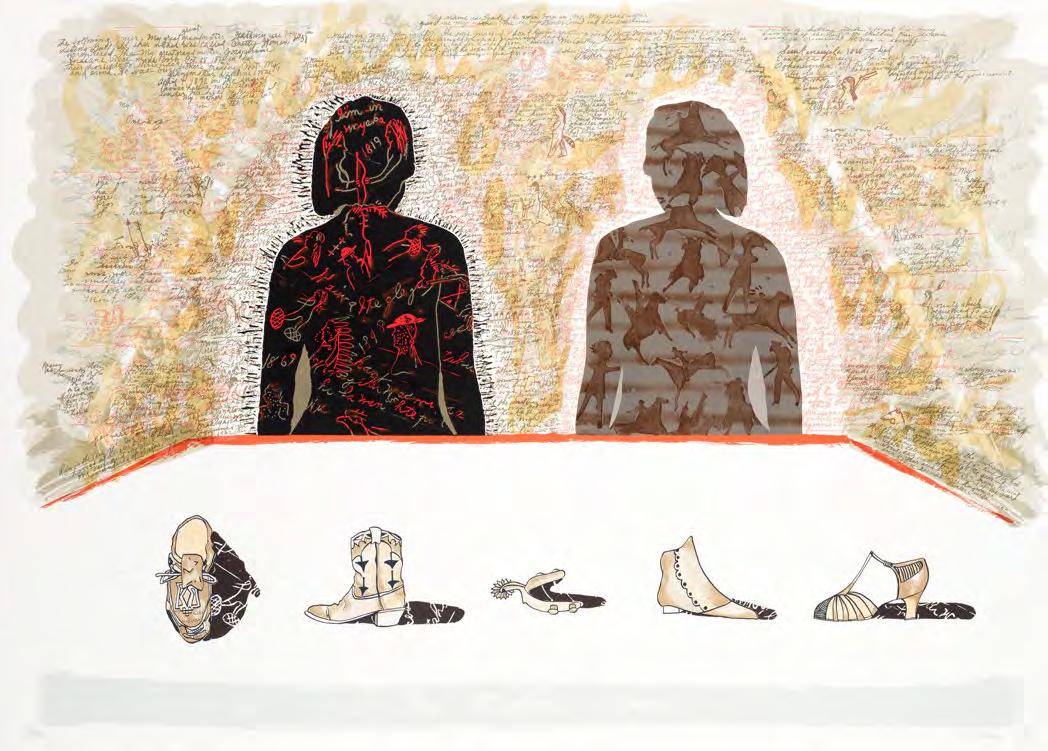
b.1949 United States of America
My Winter Count. 1999
R6 000 – 10 000
colour screenprint signed, dated, numbered 15/40 in pencil in the margin, printed with the title in the plate and embossed with The Caversham Press chop mark sheet size: 70 x 100 cm
52
Joni Brenner b.1969 Zimbabwe Fayum Portrait - Hodgins1996
R2 000 – 5 000
stone lithograph and screenprint signed, dated, numbered 12/25, inscribed with the title in pencil in the margin and embossed with The Caversham Press chop mark image size: 30 x 25 cm; sheet size: 50 x 35 cm
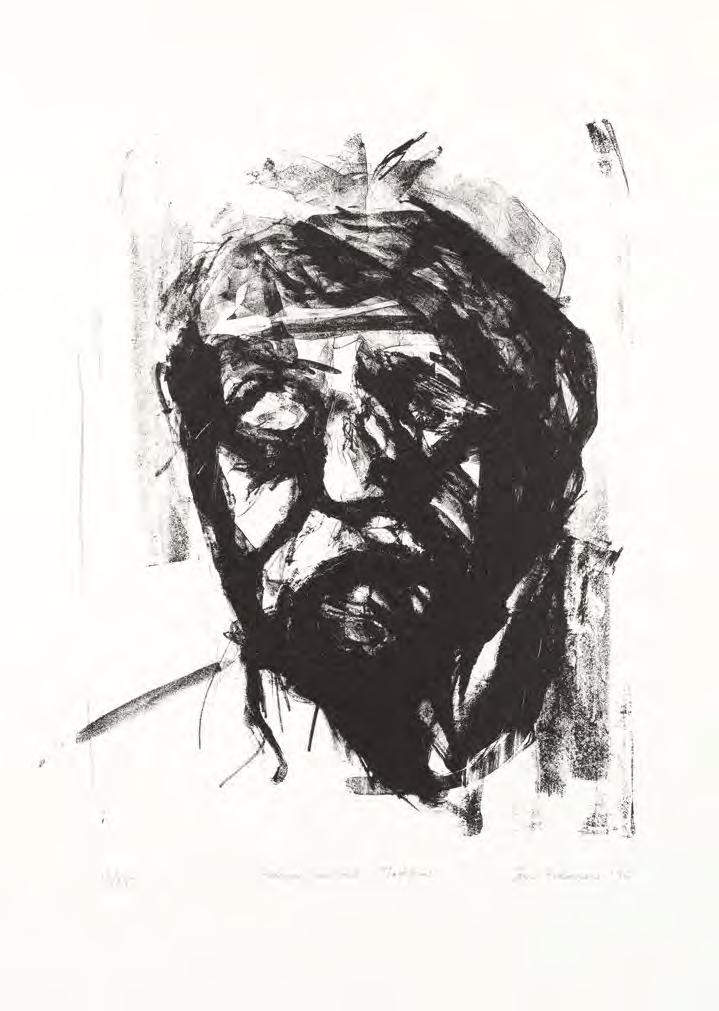
South African 1929–2014
Sometime 2001
R10 000 – 20 000
colour screenprint signed, dated, numbered 29/30, inscribed with the title in pencil in the margin and embossed with The Caversham Press chop mark image size: 57 x 86 cm; sheet size: 70 x 100 cm
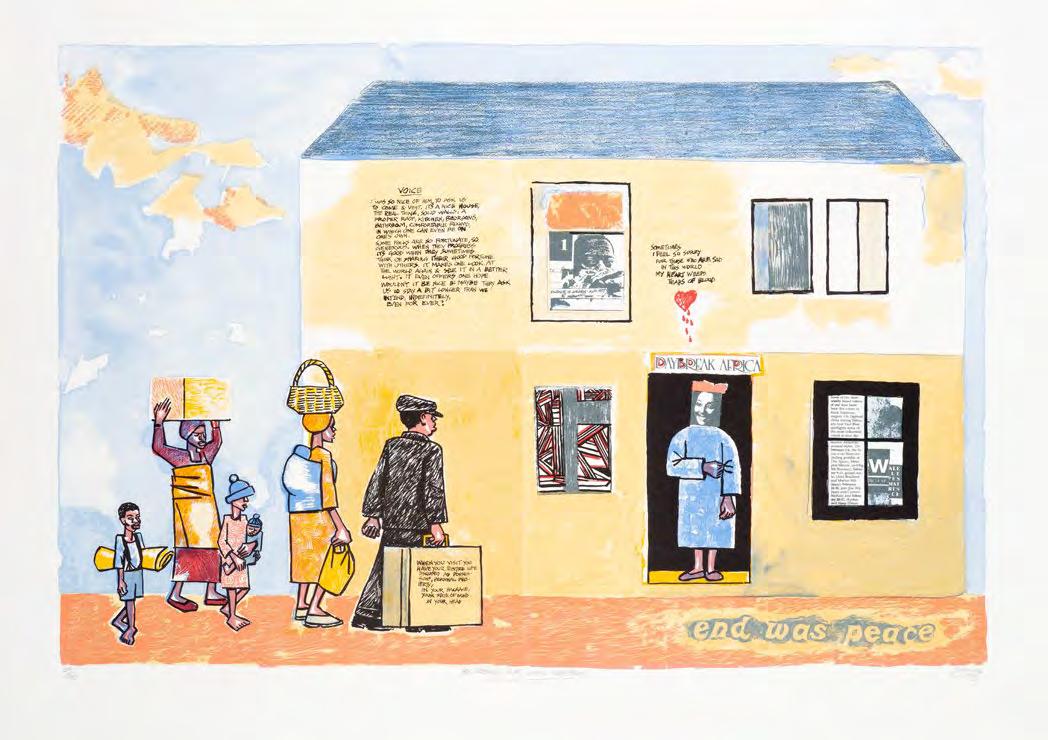
When regarding this work, Clarke’s award-winning talents as an artist, book illustrator and writer are simultaneously layered and expressed in a vibrant scene comprising illustrative lines, warm colours and texts. Upon closer inspection, however, these elements come together to reveal a deeper truth surrounding the experiences of the figures in their quest for belonging, acceptance, shelter and hope. Affected by the forced removal of his family from Simon’s Town under the policies of the apartheid government, the sentiments expressed within the piece present recurring themes in the work by Clarke.
In the course of his career and life, Clarke won multiple awards for his contributions to writing and the arts, both locally and abroad, and exhibited in countries such as the United States of America, Germany and England, to name a few.

South African 1920–2010
Egoli! Egoli! A wonderful town. A wonderful town... 1998
R5 000 – 10 000
etched linocut with colour screenprint signed, dated, numbered 21/30 in pencil in the margin, printed with the title and embossed with The Caversham Press chop mark image size: 34 x 36 cm; sheet size: 65 x 47 cm
Revisiting Hodgins’ iconic caricature of the pinstriped man in power, the juxtaposition between the work’s title and the sinister undertone makes one question the true nature of Johannesburg, or rather Egoli – ‘the place of gold’. The uncomfortable pose of the seated man dominating the foreground of the image appears to overshadow the scene. Behind him a smoking chimney rises as a symbolic reminder, perhaps, of those embroiled in the industries of Gauteng, and who stands to benefit the most from such exploits.
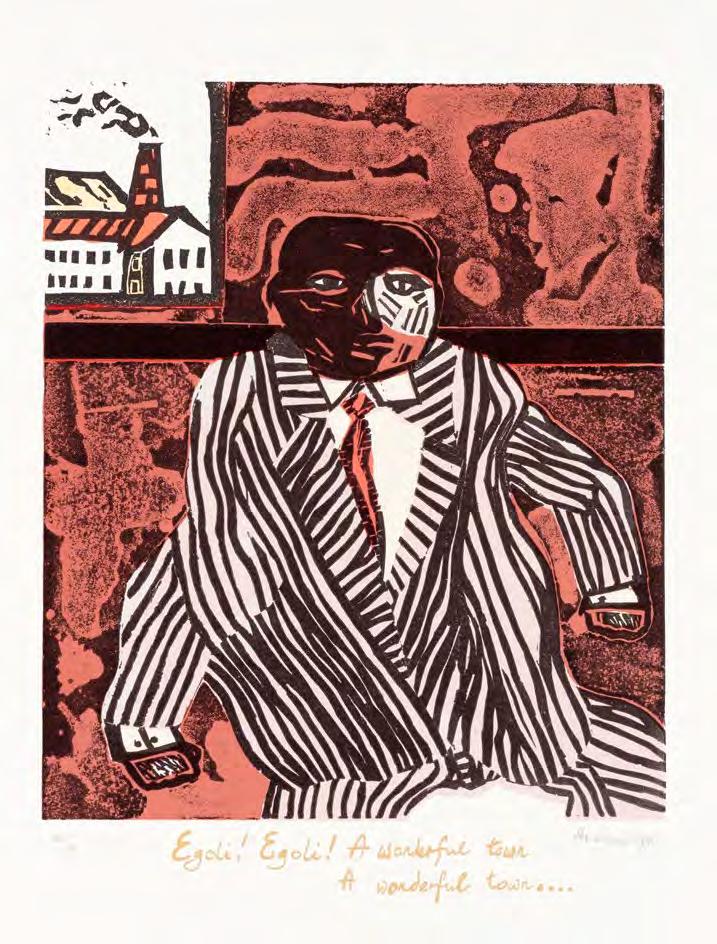
55
William Kentridgeb.1955 South Africa
The Head and the Load are the Troubles of the Neck 1995

R35 000 – 45 000 etching with drypoint signed, numbered 47/50 in pencil in the margin, printed with the title in the plate and embossed with The Caversham Press chop mark image size: 30 x 38 cm; sheet size: 42 x 64 cm
Taking its title from the Ghanaian proverb, this work plays its part in referencing the many Africans who served in the First World War, but whose contributions to the war efforts were erased and unrecorded. These individuals, who largely served as porters hauling weapons, ammunition, food and other supplies across the continent and who lost their lives in service of European powers exploiting the continent, are being recognised by Kentridge through his exploration of the history of colonialism in Africa. Furthering this subject years later, July 2018 saw Kentridge’s theatrical work The Head and the Load premier to critical acclaim at Tate Modern in London.
South African 1937–2020
Islands
1988
R10 000 – 15 000 etching (9 individual plates printed on 1 sheet) signed, dated, numbered 6/40, inscribed with the title in pencil in the margin and embossed with The Caversham Press chop mark each plate size: 10 x 10 cm; sheet size: 66 x 50 cm
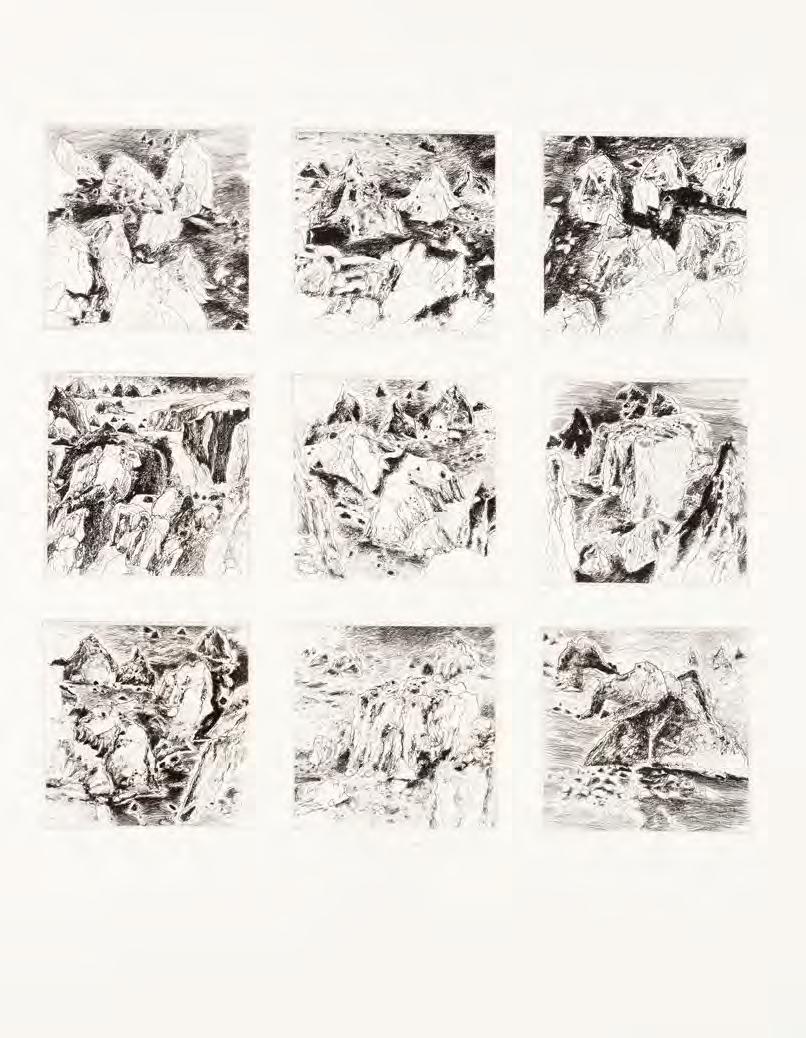
Durban-based artist, Andrew Verster was very much concerned with and inspired by his immediate community and environment. As such, his work often depicts lush, tropical scenes characteristic of the East Coast of South Africa.
Most often recognised as a painter, here we are able to appreciate Verster’s fine draughtsman skills and use of line as he depicts jagged rocks rising out of the water, like islands appearing in the Indian Ocean.
A large-scale drawing of a similar subject matter is in the permanent collection of the Tatham Art Gallery, Pietermaritzburg.
Verster sadly passed away in February this year.
South African 1937–2020
Faust in Africa I
1998
R2 000 – 4 000
linocut signed, dated, numbered 20/30, inscribed with the title in pencil in the margin and embossed with The Caversham Press chop mark image size: 29.5 x 39.5 cm; sheet size: 46 x 65 cm
South African 1937–2020
Faust in Africa II
1998
R2 000 – 4 000
linocut signed, dated, numbered 20/30, inscribed with the title in pencil in the margin and embossed with The Caversham Press chop mark image size: 29.5 x 39.5 cm; sheet size: 46 x 65 cm
South African 1937–2020
Faust in Africa III
1998
R2 000 – 4 000
linocut signed, dated, numbered 20/30, inscribed with the title in pencil in the margin and embossed with The Caversham Press chop mark image size: 29.5 x 39.5 cm; sheet size: 46 x 65 cm
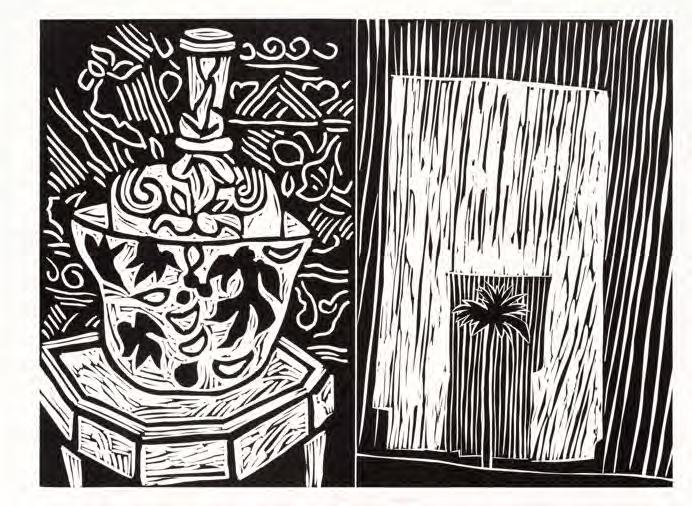
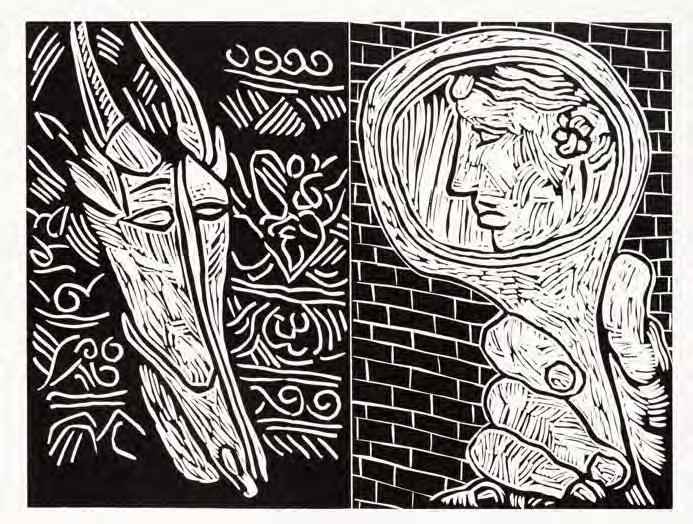

60
Cristina Cárdenas b.1957 MexicoZapatista 1999
R6 000 – 10 000
screenprint, with chine collé fragment consisting of a stone lithograph image printed on bark paper
signed, dated, numbered 19/44, inscribed with the title in pencil in the margin and embossed with The Caversham Press chop mark sheet size: 70 x 100 cm
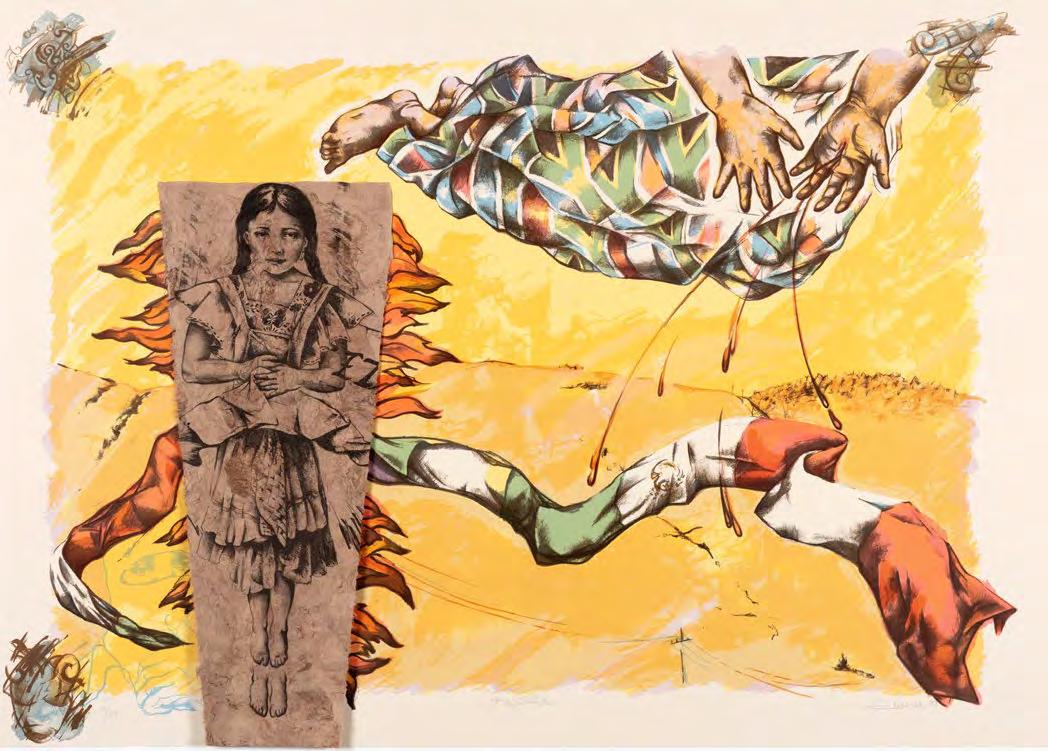
61
20th Century South Africa
Be - Earthing 2003

R6 000 – 10 000
colour screenprint signed, dated, numbered 17/29, inscribed with the title in pencil in the margin and embossed with The Caversham Press chop mark image size: 87 x 59 cm; sheet size: 100 x 70 cm

62
b.1953 South Africa
Thinking of You 2005
R3 000 – 6 000
linocut with colour screenprint signed, dated, numbered 10/30, inscribed with the title in pencil in the margin and embossed with The Caversham Press chop mark sheet size: 50 x 35 cm
63
Nayoka Idube Nengwenya 1995

R3 000 – 6 000
colour screenprint signed, dated, numbered 29/50, inscribed with the title in pencil in the margin and embossed with The Caversham Press chop mark image size: 31 x 55 cm; sheet size: 64 x 77 cm
Amadoda Amabili Abuka Indlovu Nebhubesi
R2 000 – 4 000
colour screenprint signed, dated, numbered 36/60, inscribed with the title in pencil in the margin and embossed with The Caversham Press chop mark image size: 43 x 33; sheet size: 64 x 42 cm

Qamatha 1995
R800 – 1 200
stone lithograph with colour screenprint signed, dated, numbered 27/40, inscribed with the title in pencil in the margin and embossed with The Caversham Press chop mark image size: 35 x 27 cm; sheet size: 53 x 38 cm

b.1957 South Africa Out on a Limb 1994
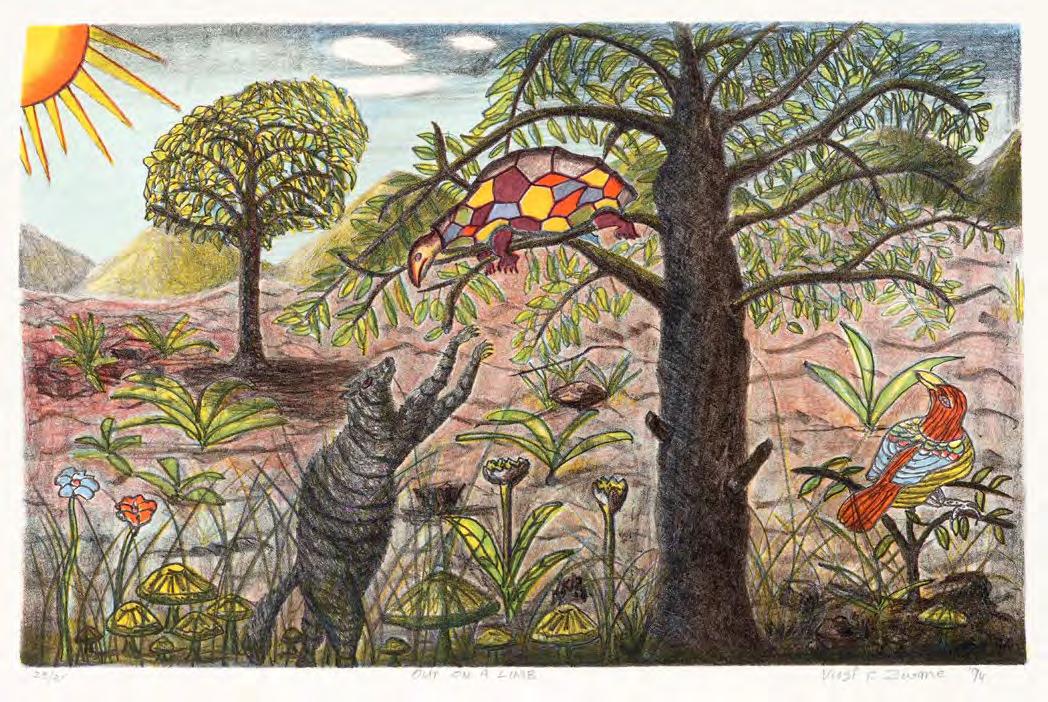
R4 000 – 8 000 stone lithograph with colour screenprint signed, dated, numbered 23/35, inscribed with the title in pencil in the margin and embossed with The Caversham Press chop mark image size: 28.5 x 44 cm; sheet size: 50.5 x 66 cm
Vusi Zwane was born in 1957 in Newcastle, KZN.
In 1974 he left school and moved to Johannesburg where he began his lifelong career as a professional artist. He spent time at FUBA Academy (Federated Union of Black Artists) where one of his teachers was Durant Sihlali. He also worked at the Amakhono Art Centre alongside artists such as Thami Jali, Sandile Zulu and Nhlanhla Xaba.
In 1993 he was one of the first participants in The Caversham Press’s newly established Educational Trust. He subsequently returned twice to create his combination screenprint/lithograph Out on a limb. Between 2010 and 2016, he was The Caversham Press Artist-in-Residence where he could concentrate on his two passions: making art and assisting with outreach projects.
67
Thamsanqa
b.1955 South Africa View from the Caversham Press 1994

R3 000 – 6 000
colour screenprint signed, dated, numbered 16/30, inscribed with the title in pencil in the margin and embossed with The Caversham Press chop mark image size: 41.5 x 59.5 cm; sheet size: 70 x 100 cm
A Bird Among Birds and Terrestrial Things, a pair
R5 000 – 10 000 linocuts
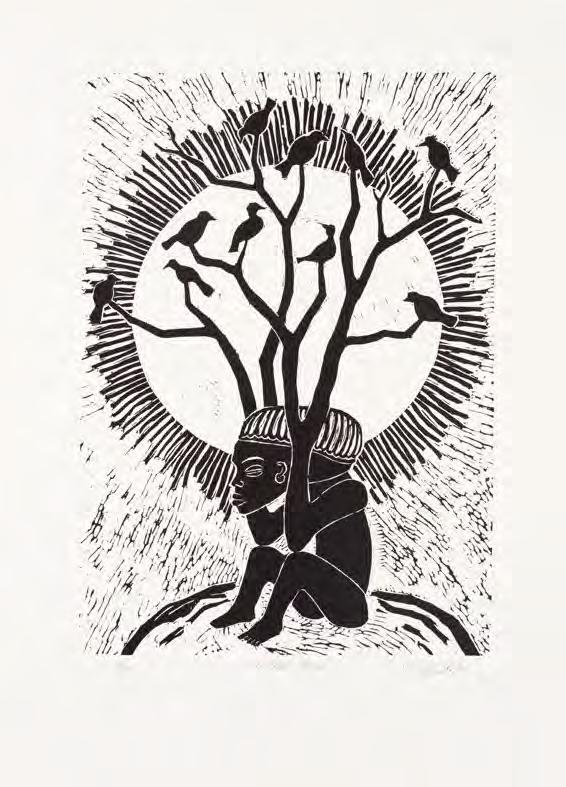

each signed, dated, numbered 17/30, inscribed with the respective title in pencil in the margin and embossed with The Caversham Press chop mark
image size: 36 x 25 each; sheet size: 50 x 35 cm each
69
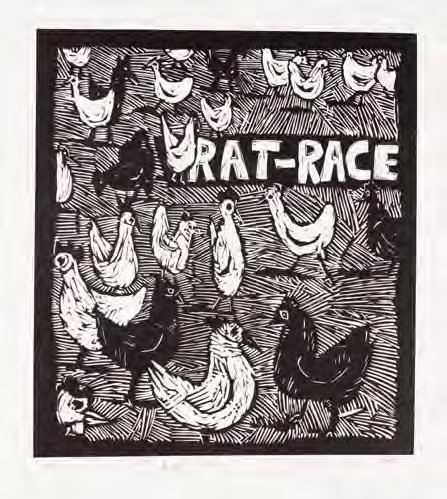
2012
R1 500 – 3 000 linocut signed, dated, numbered 13/15, inscribed with the title in pencil in the margin and embossed with The Caversham Press chop mark image size: 25.5 x 23 cm; sheet size: 48 x 35 cm

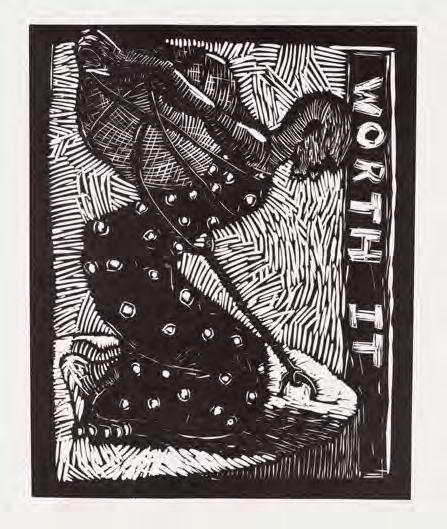
70
Colbert Mashile b.1972 South Africa
Short Cut
R1 500 – 3 000 linocut signed, dated, numbered 13/15, inscribed with the title in pencil in the margin and embossed with The Caversham Press chop mark13/15 image size: 24 x 21 cm; sheet size: 48 x 32.5
71
Colbert Mashile
b.1972 South Africa Worth It
R1 500 – 3 000 linocut signed, dated, numbered 13/15, inscribed with the title in pencil in the margin and embossed with The Caversham Press chop mark image size: 26 x 20.5 cm; sheet size: 48 x 31.5
These prints formed part of a solo exhibition at The Sherman Gallery at Boston University College of Fine Arts in September 2012.
Amazayoni 1995
R8 000 – 15 000 etching signed, dated, numbered 31/50, inscribed with the title in pencil in the margin and embossed with The Caversham Press chop mark image size: 30 x 20 cm; sheet size: 65 x 50 cm
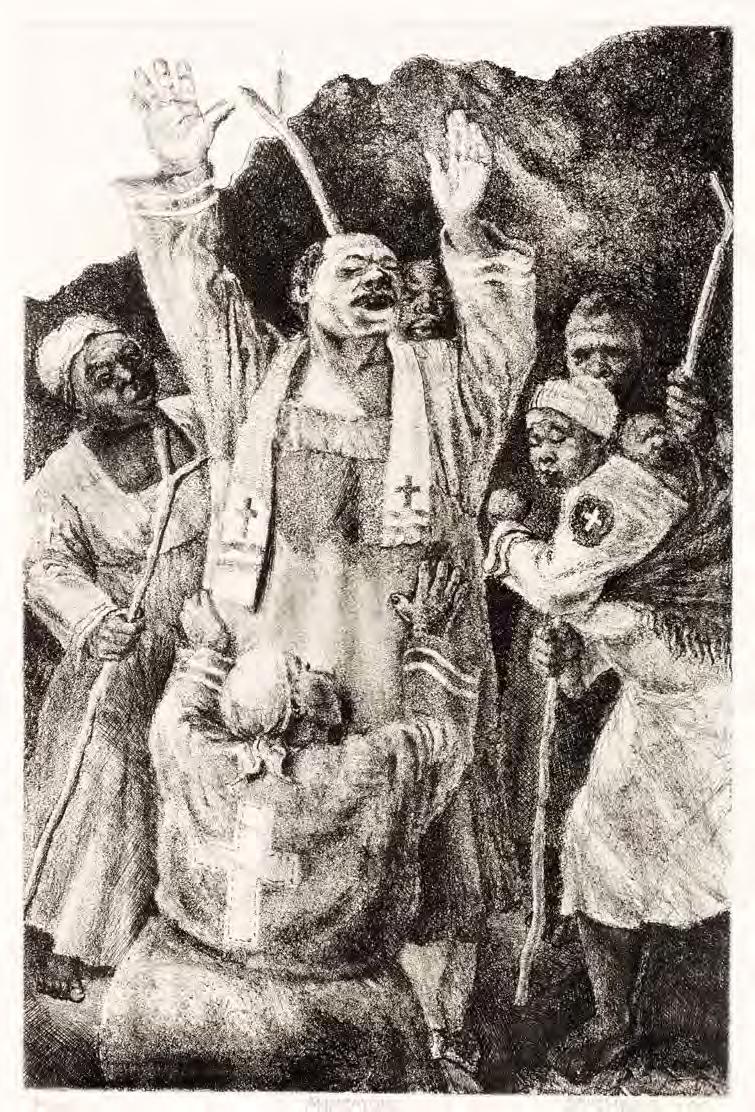
Zephria’s
1991
R4 000 – 8 000 etching signed, dated, numbered 6/25, inscribed with the title in pencil in the margin and embossed with The Caversham Press chop mark image size: 25 x 20 cm; sheet size: 50 x 33 cm
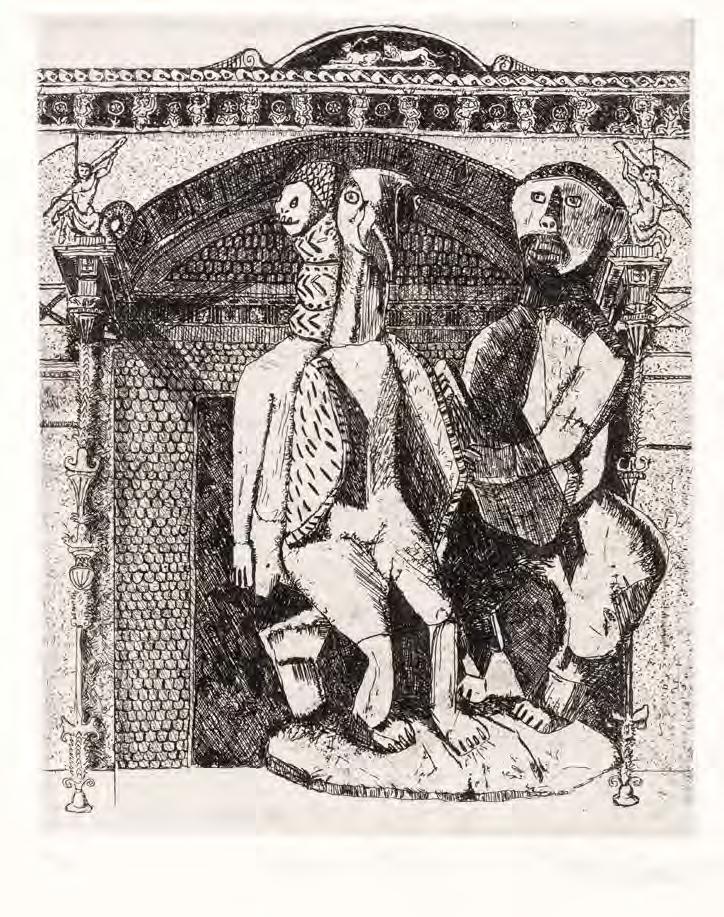
2011
R5 000 – 10 000
etching with drypoint signed, dated, numbered 24/45, inscribed with the title in pencil in the margin and embossed with The Caversham Press chop mark image size: 22 x 30 cm; sheet size: 39.5 x 53.5 cm

American 1940-1994 Passage 1999
R6 000 – 10 000
collagraph with colour screenprint signed, numbered 4/25, inscribed with the title in pencil in the margin and embossed with The Caversham Press chop mark image size: 50 x 100 cm; sheet size: 70 x 100 cm

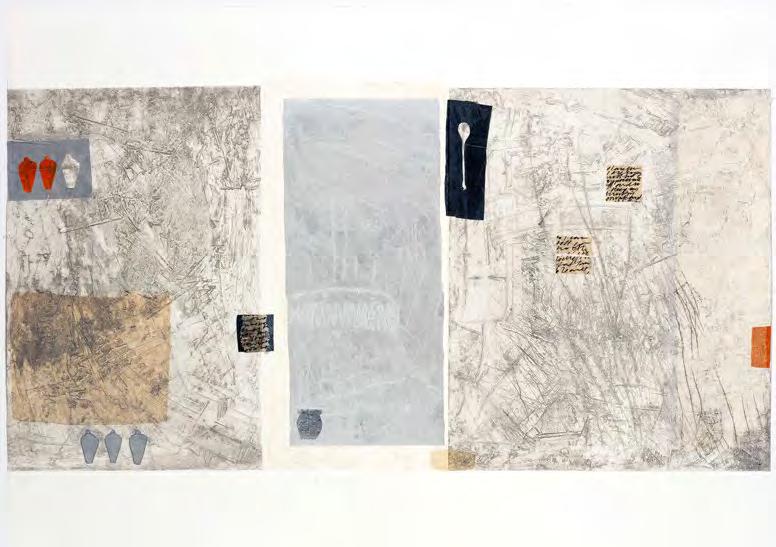
20th Century South Africa
Trace 2002
R4 000 – 8 000
colour screenprint signed, dated, numbered 18/20 in pencil in the margin and embossed with The Caversham Press chop mark sheet size: 85 x 70 cm
77
Malcolm Payne b.1946 South Africa
R6 000 – 10 000
colour screenprint signed, dated, numbered 12/14 in pencil in the margin and embossed with The Caversham Press chop mark
image size: 85 x 61 cm; sheet size: 107 x 79 cm
Hobbs, P and Rankin, R. (1997). Printmaking in a Transforming South Africa. Cape Town: David Philip Publishers (Pty) Ltd, another example from the edition illustrated in colour on p.190.

b.1952 South Africa Minister, Minister; Waar sal jy Skuil?
1991
R5 000 – 10 000 colour screenprint signed, dated, numbered 12/14, inscribed with the title in pencil in the margin and embossed with The Caversham Press chop mark image size: 33 x 65 cm; sheet size: 79 x 108 cm
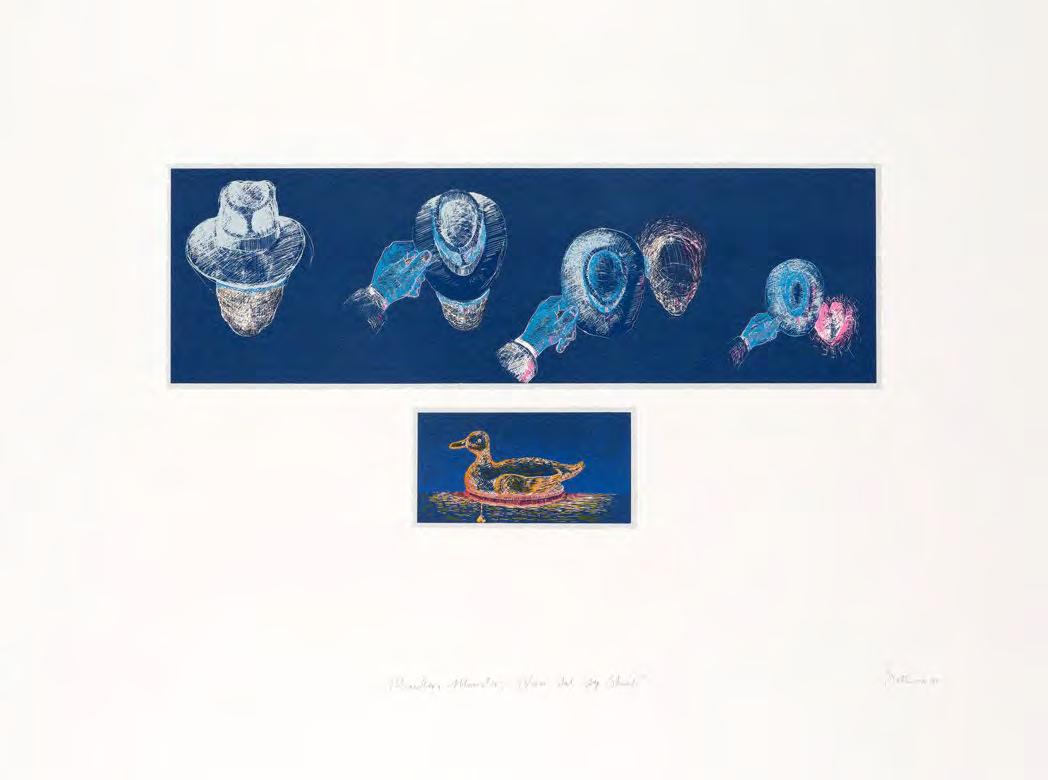
79
Gavin Younge
b.1947 South Africa
Home Truths I 1991
R2 500 – 3 500
colour screenprint signed, dated, numbered 13/20, inscribed with the title in pencil in the margin and embossed with The Caversham Press chop mark image size: 30 x 27 cm each; sheet size: 53 x 42 cm each
LITERATURE Geers, K (ed). (1997). Contemporary South African Art: The Gencor Collection. Johannesburg: Jonathan Ball Publishers (Pty) Ltd. another example from the edition illustrated in colour on p.79.
80
Gavin Younge
b.1947 South Africa
Home Truths II 1991
R2 500 – 3 500
colour screenprint signed, dated, numbered 13/20, inscribed with the title in pencil in the margin and embossed with The Caversham Press chop mark image size: 30 x 27 cm each; sheet size: 53 x 42 cm each
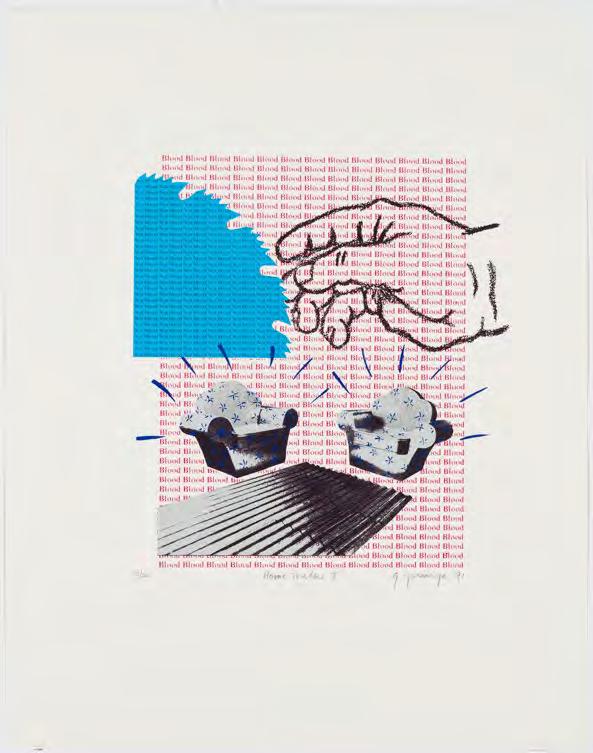

LITERATURE
Geers, K (ed). (1997). Contemporary South African Art: The Gencor Collection. Johannesburg: Jonathan Ball Publishers (Pty) Ltd. another example from the edition illustrated in colour on p.79.
81
Zamaxolo Dunywa
20th Century South Africa
Ucansi/Cansi (Womb/Bowl) 2003
R3 000 – 6 000
colour screenprint signed, dated, numbered 21/28, inscribed with the title in pencil in the margin and embossed with The Caversham Press chop mark image size: 79 x 52 cm; sheet size: 100 x 70 cm
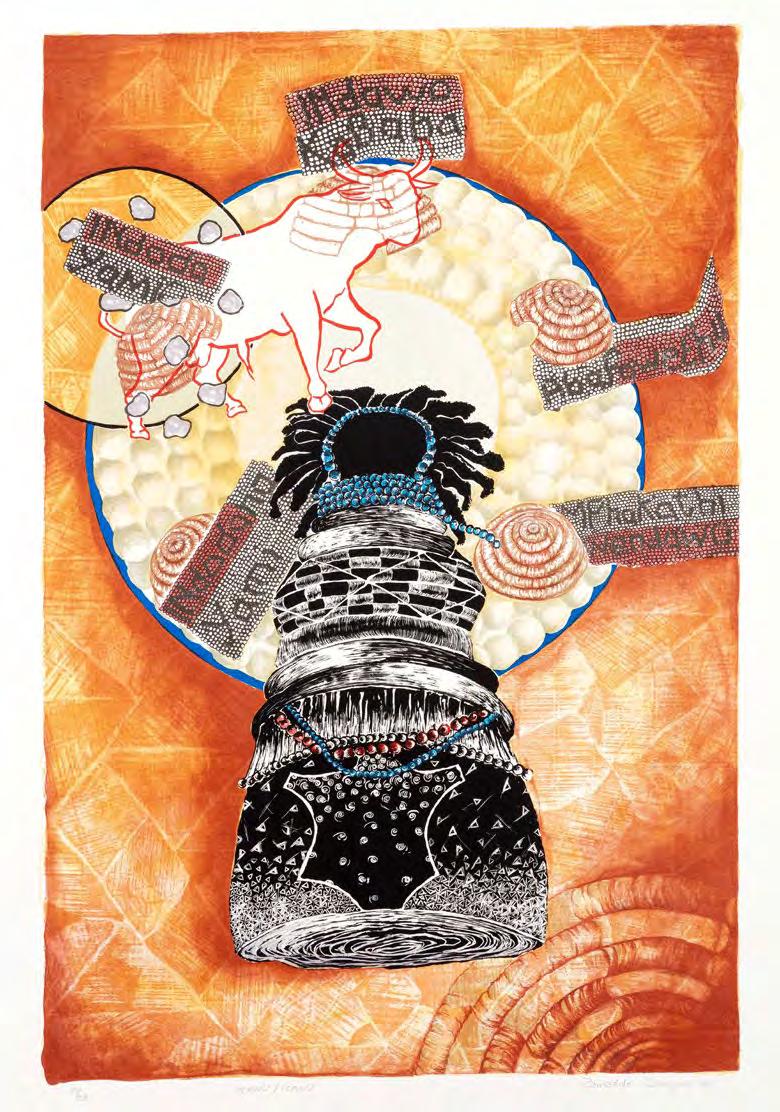

Flight 1991
R6 000 – 10 000
colour screenprint signed, dated, numbered 12/14 and inscribed with the title in pencil in the margin and embossed with The Caversham Press chop mark image size: 83 x 56 cm; sheet size: 108 x 85 cm
times from my past 1999
R4 000 – 8 000 linocut signed, dated, numbered 19/45, inscribed with the title in pencil in the margin and embossed with The Caversham Press chop mark image size: 60 x 76 cm; sheet size: 70 x 100 cm

84
Vuminkosi Zulu South African 1948-1996
Monkey and the Crocodile 1995
R2 000 – 4 000
linocut signed, dated, numbered 13/60, inscribed with the title in pencil in the margin and embossed with The Caversham Press chop mark image size: 34 x 50 cm; sheet size: 47 x 84 cm

85
Vusi Zwane b.1957 South Africa
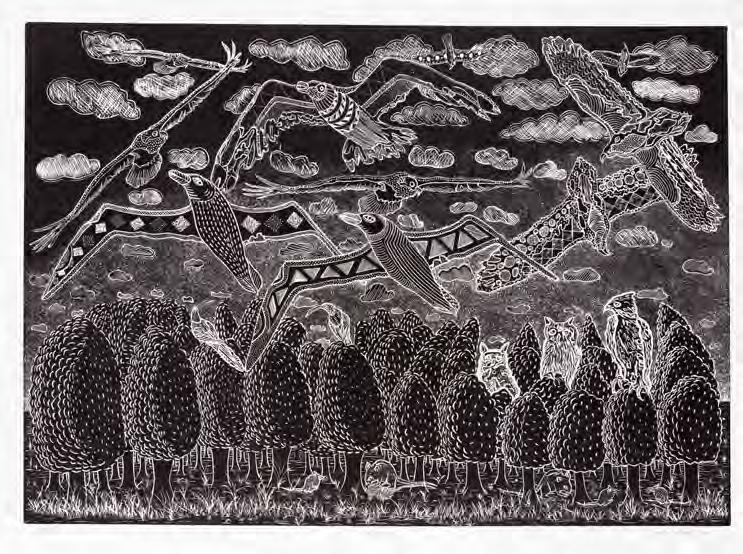
Imbizo 2014
R2 500 – 5 000
linocut signed, dated, numbered 13/40, inscribed with the title in pencil in the margin and embossed with The Caversham Press chop mark image size: 39 x 54.5 cm; sheet size: 48 x 65 cm
86
Michelle Tejuola Turner b.1956 United States of America Acts 2:38 2000 R5 000 – 10 000 colour screenprint signed, dated, numbered 25/40, inscribed with the title in pencil and embossed with The Caversham Press chop mark sheet size: 50 x 65 cm

87
South African 1942-2008
Constellation 3 2005
R3 000 – 6 000
linocut with colour screenprint signed, dated, numbered 10/30 inscribed with the title in pencil in the margin and embossed with The Caversham Press chop mark sheet size: 50 x 35 cm
88
Walter Oltmannb.1960 South Africa
Beaded Waistcoat 2005

R3 000 – 6 000
linocut with colour screenprint signed, dated, numbered 10/30 inscribed with the title in pencil in the margin and embossed with The Caversham Press chop mark image size: 50 x 35 cm; sheet size: 70 x 100 cm

Velile Soha b.1957 South Africa Continuation of My Life 2002
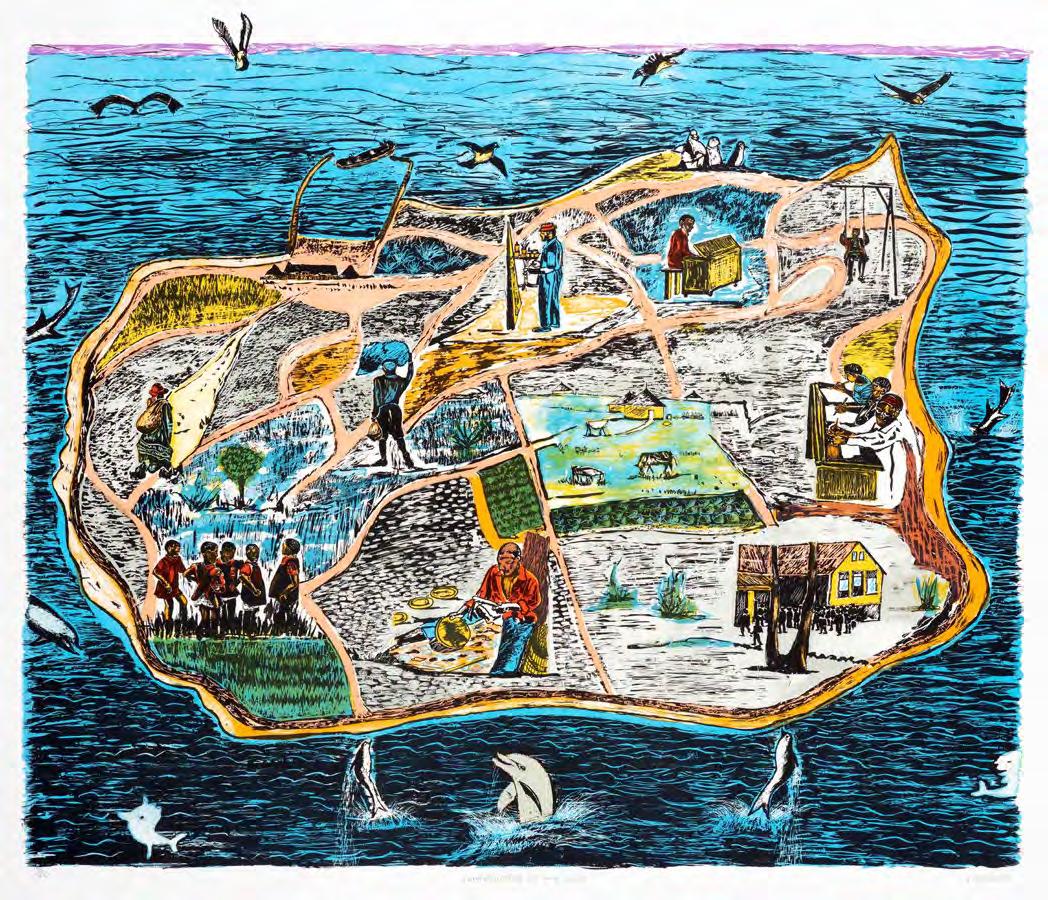
R4 000 – 8 000
colour screenprint signed, dated, numbered 15/20, inscribed with the title in pencil in the margin and embossed with The Caversham Press chop mark image size: 63 x 73 cm; sheet size: 70 x 83 cm
90
Lallitha Jawahirilal b.1955 South Africa
Oh South Africa, a Silver and Gold Right Floods the Beloved Country 1994
R3 000 – 6 000
colour screenprint signed, dated, numbered 16/30, inscribed with the title in pencil in the margin and embossed with The Caversham Press chop mark image size: 41.5 x 59.5 cm; sheet size: 70 x 100 cm
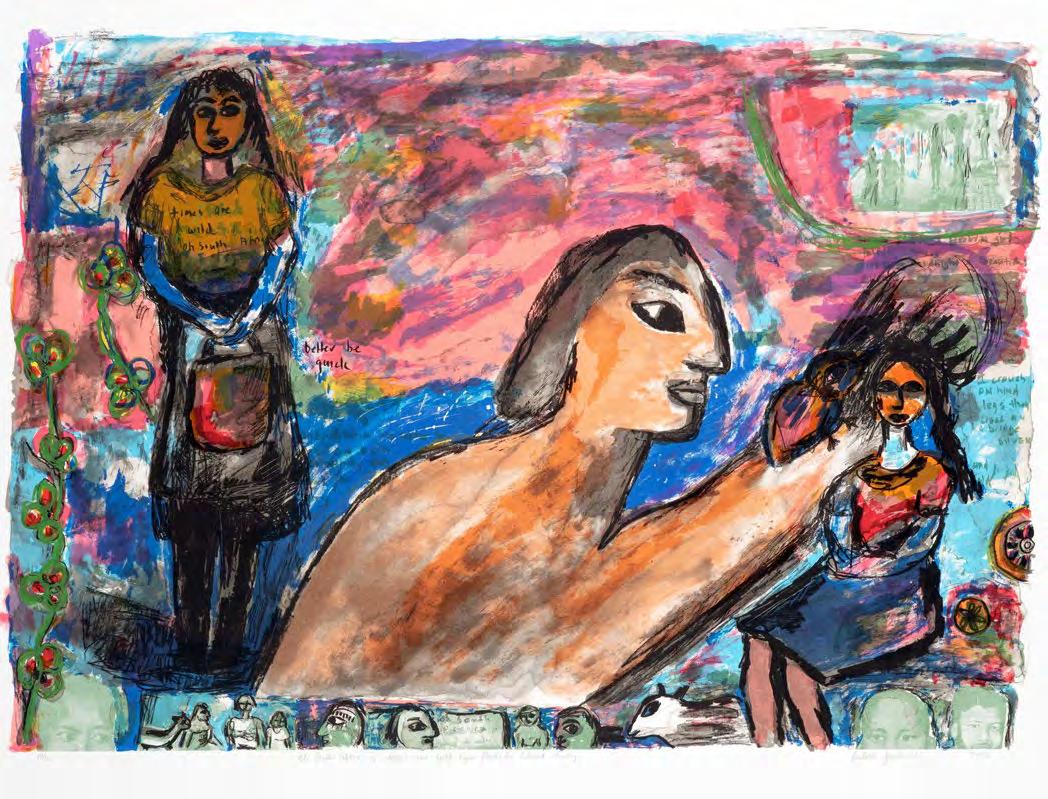
51 11, 12, 13, 45 8, 30 1 65 78 52 46 43 60 24 25 9, 10, 53 49, 50 81 15, 16 73 61 3, 4, 17, 18, 20, 34, 35, 44, 54 67 90 47 75 2, 7, 19, 22, 23, 33, 40, 55
Allen, L Arnold, M Bell, D Bell, Hodgins & Kentridge Beyi, N Botha, A Brenner, J Bukani, E Buthelezi, SM Cárdenas, C Catherine, N Cebekhulu, S Clarke, P Cozier, C Dunywa, Z Findlay, B Halstead-Berning, F Hamer, A Hodgins, R Jali, T
Jawahirilal, L Jones, M Kennedy, E Kentridge, W
14, 74 76 69, 70, 71 26, 27 31, 32 21 88 77 83 37, 38, 39 36, 68, 87 28, 29 64 41, 42, 72 5, 6, 62 89 86 56, 57, 58, 59 48 63 79, 80, 82 84 66, 85
Koloane, D Marriott, R Mashile, C Nkosi, G Ntshalintshali, B Nyezwa, Zwane & Cebekhulu Oltmann, W Payne, M Peters, S Richards, C Schütz, P Sebidi, MMH Shabalala, M Sibisi, S Siopis, P Soha, V Tejuola Turner, M Verster, A Vorster, M Xaba, V Younge, G Zulu, V Zwane, V
visit https://aspireart.net/wp-content/uploads/2019/10/AAA-Conditions-of-Business-2019.pdf
SALE DATE: 19 March 2020
SALE TITLE: Aspire X Caversham
SALE VENUE: Aspire Art Auctions, Illovo Edge, Buiding 3, Ground Floor, 5 Harries Road, Illovo, Johannesburg
ABSENTEE BID Written bids must be received at least 24 hours prior to commencement of the auction.
For dealers, please ensure the billing name and address corresponds with the company VAT number. Aspire cannot re–invoice or re–issue an invoice in a different name from the one listed on this form. Aspire will confirm receipt of all written bids telephonically or by email within one business day.
LOTS – Please print clearly
ID NUMBER: ADDRESS:
For new bidders at Aspire Art Auctions, please attach a copy of the following documents: Proof of identity (ID document, Drivers License or Passport) Proof of current address
I accept that if Aspire receives identical written bids on the same lot, the bid received first will take precedence.
I understand that written bids and telephone bids are a free and confidential service.
While Aspire will be as careful as can reasonably be expected in processing these bids, Aspire will not be liable for any problems with this service or missed bids.
I have read and agree to the Conditions of Business https://aspireart. net/wp–content/uploads/2017/02/Aspire–Terms.pdf and agree to be bound by the terms laid out therein.
Bidding generally starts below the low estimate and increases in increments of approximately 10%. The auctioneer may vary increments during the course of the auction at his/her own discretion.
